Hanwha Techwin DIGIMAXU-CA5 Digital Camera User Manual UC2 en c V07
Samsung Techwin Co Ltd Digital Camera UC2 en c V07
Contents
- 1. Users Manual 1 of 2
- 2. Users Manual 2 of 2
Users Manual 1 of 2
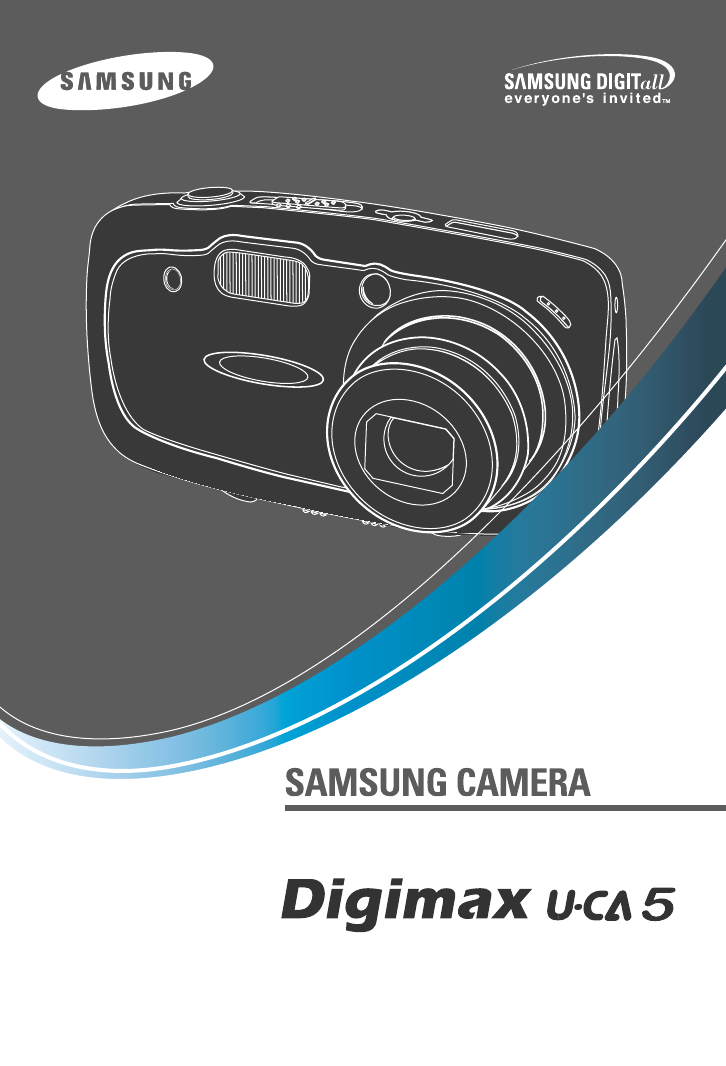
Thank you for buying a Samsung Camera.
This manual will guide you through using the camera, including capturing images, downloading images and
using the application software. Please read this manual carefully before using your new camera.
ENGLISH
User's Manual
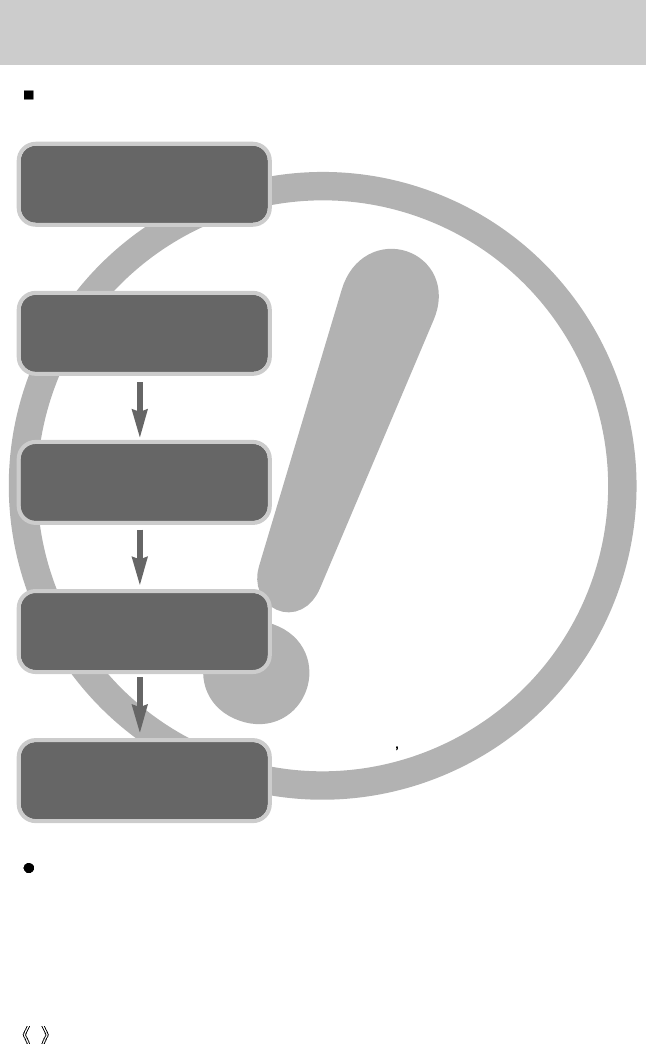
2
Instructions
Use this camera in the following order
Insert the
USB cable
Set up the
camera driver
Before connecting the camera to a PC, via the
USB cable, you will need to set up the camera
driver. Install the camera driver that is contained in
Application software CD-ROM. (p.90)
Take a picture (p.19)
* When taking a picture, you should use the
rechargeable battery supplied with the camera.
Insert the supplied USB cable into the PC’s USB
port and the camera’s USB connection terminal.
(p.98)
Check the camera’s power. If the power is turned
off, press the camera button to turn it on. (p.22)
Take a picture
Check the
camera’s power
Check
[Removable Disk]
Open Window s EXPLORER and search for
[Removable Disk]. (p.99)
If you use a card reader to copy the images on the memory card to your PC, the images
could be damaged. When transferring the images taken with the camera to your PC, be sure
to use the supplied USB cable to connect the camera to your PC. Please note that the
manufacturer holds no responsibility for loss or damage of images on the memory card due
to the use of a card reader.

3
Contents
Getting to know your camera 5
About the icons 5
Danger 6
Warning 6
Caution 7
An FCC warning 7
System chart 8
Identification of features 10
Front & Top 10
Back & Bottom 10
Side/ 5-function button 11
Cradle 12
Movie clip mode 12
Voice recording mode 12
Still image mode 12
Connecting to a Power Source 13
Using the SAC-41
(for both Charger and AC adapter) 14
How to charge the rechargeable battery
(SLB-1137) 14
Using the batteries 17
Removing the battery 17
Maintenance of the memory card 18
Preserving the memory card data 18
Instructions on how to use the memory card
19
Inserting the memory card 20
Removing the memory card 20
When Using the Camera for the First Time
21
LCD monitor indicator 22
Starting the recording mode 23
Things to Watch Out for When Taking
Pictures 26
Using the camera buttons to adjust the
camera 27
POWER button 27
SHUTTER button 27
ZOOM W/T button 27
Voice memo/ UP button 29
Recording a voice memo 29
Macro / Down button 30
Focus lock 31
Flash/ Left button 32
Self-timer/ Remote/ Right button 35
MENU/ OK button 37
M button : selecting preset scene modes 38
+/- button 39
LCD button 43
Using the LCD monitor to adjust the
camera settings 44
How to use the menu 46
Mode 46
Size 47
Quality 48
Metering 49
Continuous shot 49
Sharpness 50
Effect 50
Special Effect 51
Special Effect : Preset focus frames 51
Special Effect : Composite shots 52
Special Effect : Photo Frame 51
Starting play mode 55
Playing back a still image 55
Playing back a movie clip 56
How to capture the movie clip 56
Playing back a movie clip 56
RECORDING
PLAY
READY

4
Contents
How to capture the movie clip 56
Playing back a recorded voice 56
Using the camera buttons to adjust the
camera 59
Thumbnail / Enlargement button 59
Voice memo / Up button 60
Play & Pause/ Down button 61
LEFT/ RIGHT/ MENU/ OK button 62
LCD button 62
Album button (M button) 63
How to use the album 63
Removing still images from the album 64
Playing back the albums 65
Delete button 66
Setting up the play back function using the
LCD monitor 67
Starting the slide show 70
Protecting images 71
Deleting images 72
Resize 73
Rotating an image 74
DPOF 74
DPOF : STANDARD 75
DPOF : INDEX 75
DPOF : PRINT SIZE 76
PictBridge 77
PictBridge: Picture Selection 78
PictBridge: Print Setting 79
PictBridge: Printing 80
PictBridge : RESET 81
Setup menu 82
File name 83
Auto power off 84
Language 85
Formatting a memory card 85
Setting up the Date/ Time/ Date type 86
Imprinting the recording date 86
Sound 87
Connecting an External Device (USB) 87
Function lamp 88
Auto Focus lamp 89
LCD brightness 89
Selecting Video out type 90
Quick view 92
Initialisation(RESET ALL) 92
Setting up the MYCAM menu 93
Start up image 93
Start up sound 94
Important notes 95
Warning indicator 97
Before contacting a service centre 98
Specifications 101
Software Notes 88
System Requirements 88
About the software 89
Setting up the application software 90
Starting PC Mode 98
Removing the USB Driver for Windows
98SE 101
Removable Disk 102
Removing the removable disk 103
Setting up the USB Driver for MAC 104
Using the USB Driver for MAC 104
Digimax Viewer 2.1 105
Using PhotoImpression 106
Digimax Reader 107
FAQ 109
SETUP
SOFTWARE
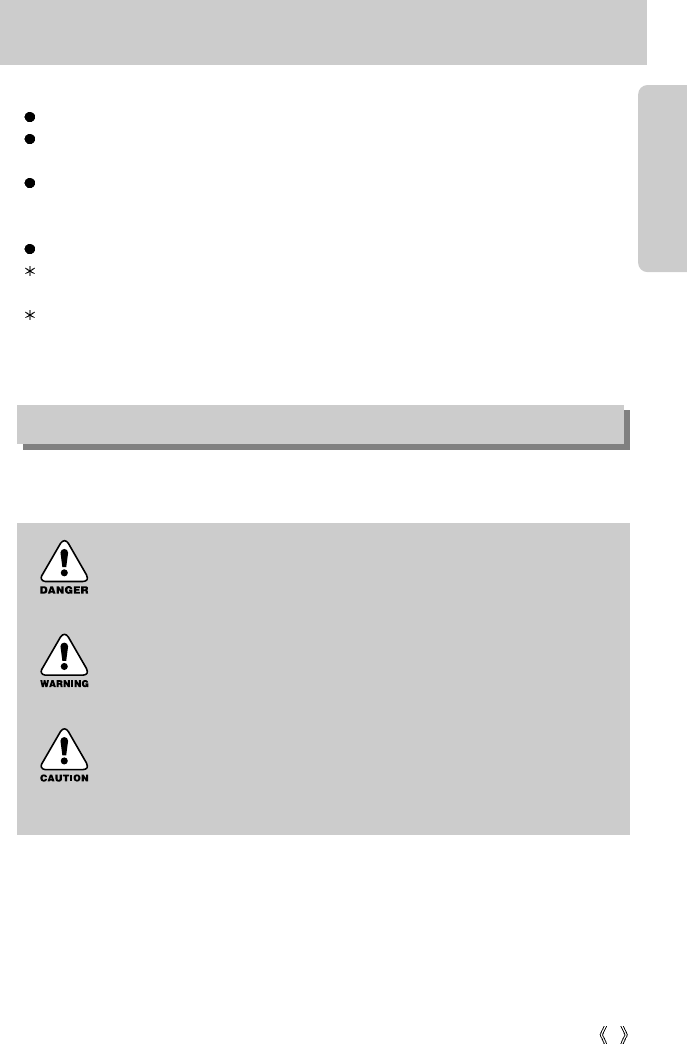
5
Getting to know your camera
Thank you for buying a Samsung Digital Camera.
Prior to using this camera, please read the user manual thoroughly.
When you require After Sales service, please bring the camera and the cause of the camera
malfunction (such as Batteries, Memory card etc.) to the A/S centre.
Please check that the camera is operating properly prior to when you intend to use it (e.g. for
a trip or an important event) to avoid disappointment. Samsung camera takes no
responsibility for any loss or damages that may result from camera malfunction.
Keep the manual in a safe place.
Microsoft, Windows and Windows logo are registered trademarks of Microsoft Corporation
incorporated in the United States and/or other countries.
All brand and product names appearing in this manual are registered trademarks of their
respective companies.
This manual contains instructions on using this camera that will help you to use this camera
safely and correctly. This will help prevent danger and injury to others.
About the icons
DANGER
DANGER indicates an imminently hazardous situation which, if not avoided, will
result in death or serious injury.
WARNING
WARNING indicates a potentially hazardous situation, which, if not avoided,
could result in death or serious injury.
CAUTION
CAUTION indicates a potentially hazardous situation, which, if not avoided, may
result in a minor or moderate injury.

NOTE: This equipment has been tested and found to comply with the limits
for a Class B digital device, pursuant to part 15 of the FCC Rules. These
limits are designed to provide reasonable protection against harmful
interference in a residential installation.
This equipment generates, uses and can radiate radio frequency energy and,
if not installed and used in accordance with the instructions, may cause
harmful interference to radio communications. However, there is no
guarantee that interference will not occur in a particular installation. If this
equipment does cause harmful interference to radio or television reception,
which can be determined by turning the equipment off and on, the user is
encouraged to try to correct the interference by one or more of the following
measures:
- Reorient or relocate the receiving antenna.
- Increase the separation between the equipment and receiver.
- Connect the equipment into an outlet on a circuit different from that to
which the receiver is connected.
- Consult the dealer or an experienced radio/TV technician for help.
CAUTION : Changes or modifications not expressly approved by the party
responsible for compliance could void the user’s authority to operate the
equipment.
Information to the user
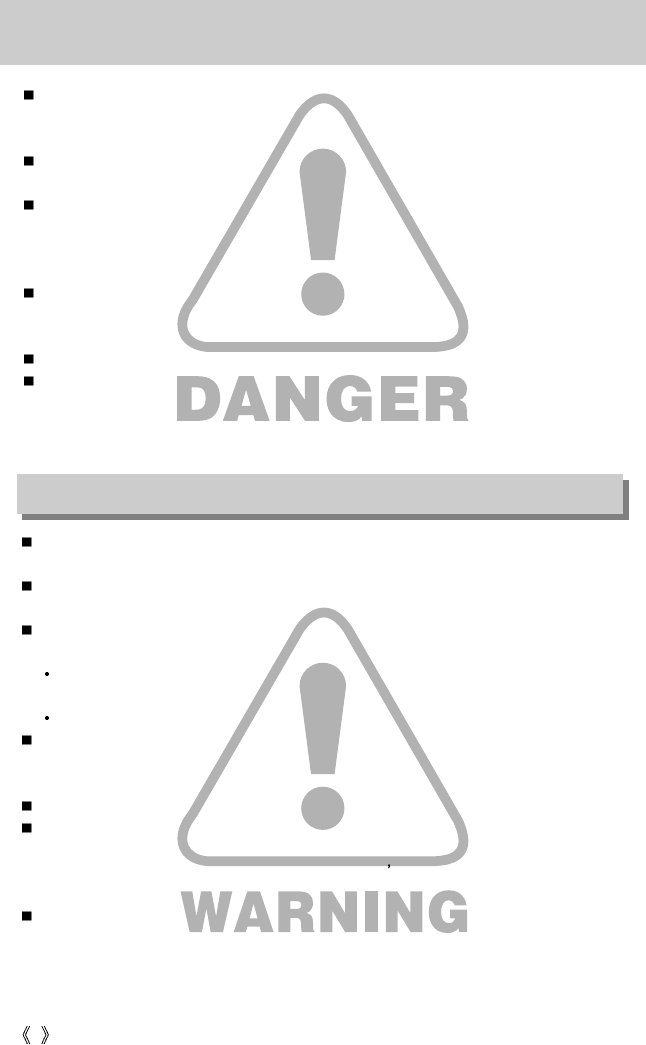
6
Danger
Do not attempt to modify this camera in any way. This may result in fire, injury, electric shock
or severe damage to you or your camera. Internal inspection, maintenance and repairs
should be carried out by your dealer or Samsung Camera Service centre.
Please do not use this product in close proximity to flammable or explosive gases, as this
could increase the risk of explosion.
Should any form of liquid or a foreign object enter the camera, do not use it. Switch off the
camera, and then disconnect the power source (batteries or AC Power Adapter). You must
contact your dealer or Samsung Camera Service centre. Do not continue to use the camera
as this may cause a fire or electric shock.
Do not insert or drop metallic or inflammable foreign objects into the camera through access
points e.g. the memory card slot and battery chamber. This may cause a fire or electric
shock.
Do not operate this camera with wet hands. This could pose a risk of electric shock.
You should use the rechargeable battery supplied with the camera. Do not use the AC
adapter and non rechargeable battery at the same time. It may cause an explosion.
Do not use the flash in close proximity to people or animals. Positioning the flash too close to
your subject’s eyes, may cause eyesight damage.
When taking photographs, never point the lens of the camera directly into very strong light.
This may result in permanent damage to your eyesight.
For safety reasons keep this product and accessories out of reach of children or animals to
prevent accidents e.g.:
Swallowing batteries or small camera accessories. If an accident should occur, please
consult a doctor immediately.
There is the possibility of injury from the camera’s moving parts.
Batteries and camera may become hot during prolonged use and it may result in camera
malfunction. Should this be the case, allow the camera to sit idle for a few minutes to allow it
time to cool.
Do not recharge non rechargeable batteries. This may cause an explosion.
Do not leave this camera in places subject to extremely high temperatures, such as a sealed
vehicle, direct sunlight or other places of extreme variances in temperature. Exposure to
extreme temperatures may adversely affect the camera s internal components and could
cause a fire.
When in use, do not cover the camera or AC Power Adapter. This may cause heat to build up
and distort the camera body or cause a fire. Always use the camera and its accessories in a
well-ventilated area.
Warning

7
Caution
Leaking, overheating, or burst batteries could result in fire or injury.
Use batteries with the correct specification for the camera.
Do not short circuit, heat or dispose of batteries in fire.
Do not insert the batteries with the reverse polarities.
Remove the batteries when not planning to use the camera for a long period of time.
Batteries may leak corrosive electrolyte and permanently damage the camera's components.
Do not fire the flash while it is in contact with hands or objects. Do not touch the flash after
using it continuously. It may cause burns.
Do not move the camera while it is switched on, if you are using the AC Power Adapter.
After use, always switch off the camera before unplugging the adapter from the wall socket.
Then make sure that any connector cords or cables to other devices are disconnected before
moving the camera. Failure to do so may damage the cords or cables and cause a fire or
electric shock.
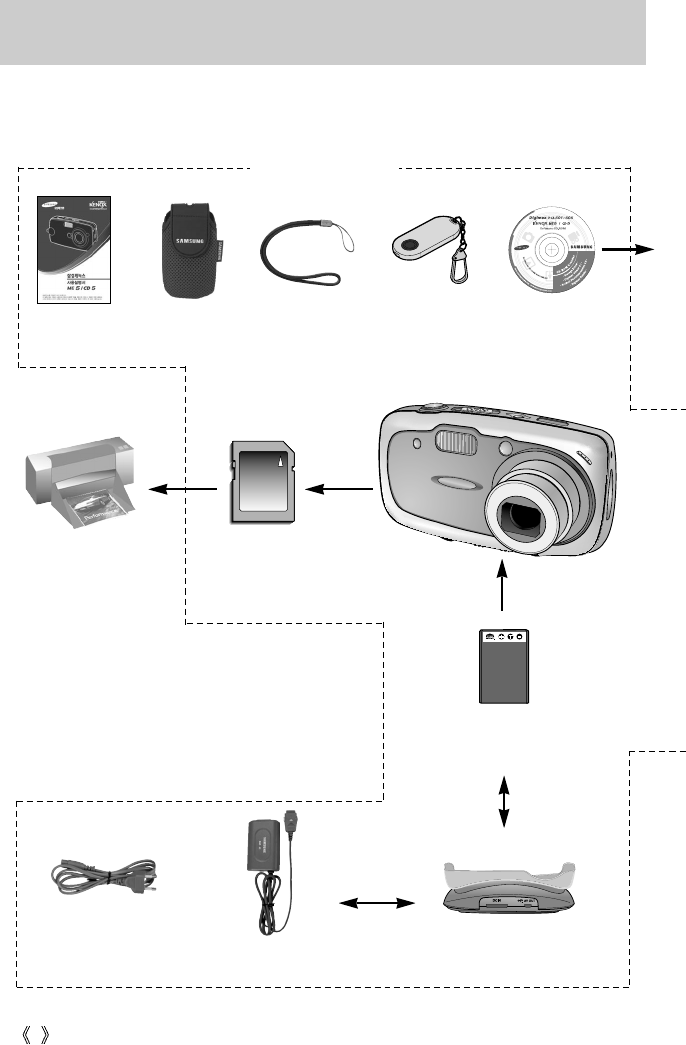
8
System chart
Please check that you have the correct contents before using this product. The contents can
vary depending on the sales region. To buy the optional equipment, contact your nearest
Samsung dealer or Samsung service centre.
Pouch
User manual,
Product warranty
Camera strap Remote control Software CD
(see p.90)
SD memory card
(see p.15)
DPOF compatible
printer (see p.59)
Rechargeable battery
(SLB-1137)
Cradle
SAC-41
(for both Charger and AC adapter)
AC cord
< Included items >
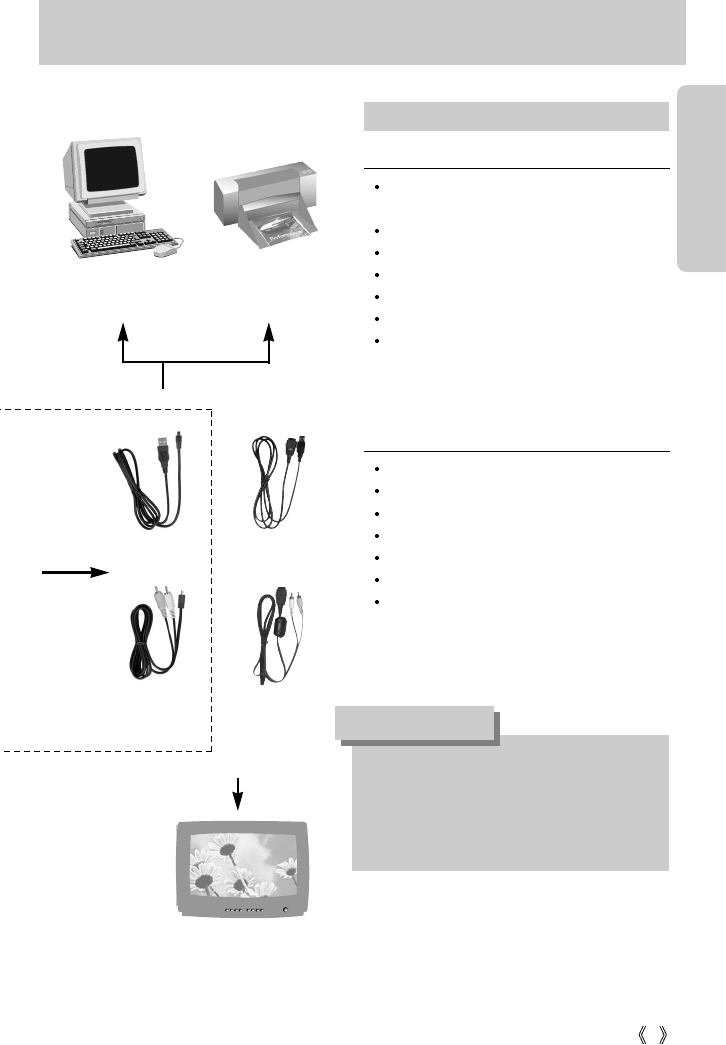
9
System chart
PictBridge compatible
printer(see p.63)
Computer
(see p.98)
External monitor
Yellow colour - Video,
White colour - Voice
(see p.83)
For Windows
PC with processor better than MMX Pentium
233MHz (XP : Pentium II 300MHz)
Windows 98/98SE/2000/ME/XP
Minimum 32MB RAM (XP : 128MB)
140MB of available hard-disk space
USB port
CD-ROM drive
800x600 pixels, 16-bit colour display
compatible monitor
(24-bit colour display recommended)
For Macintosh
Power Mac G3 or later
Mac OS 9.0 ~ 10.3
Minimum 64MB RAM
110MB of available hard-disk space
USB port
CD-ROM drive
QuickTime 6.01 or later for Movie Clip
System Requirements
When you connect the camera to a
computer, printer or external monitor, you
have to use the USB/ Video cable supplied
with the camera, or the external devices can't
recognise the camera.
CAUTION
USB cable
(for Cradle)
USB cable
(for Camera)
AV cable
(for Cradle)
AV cable
(for Camera)
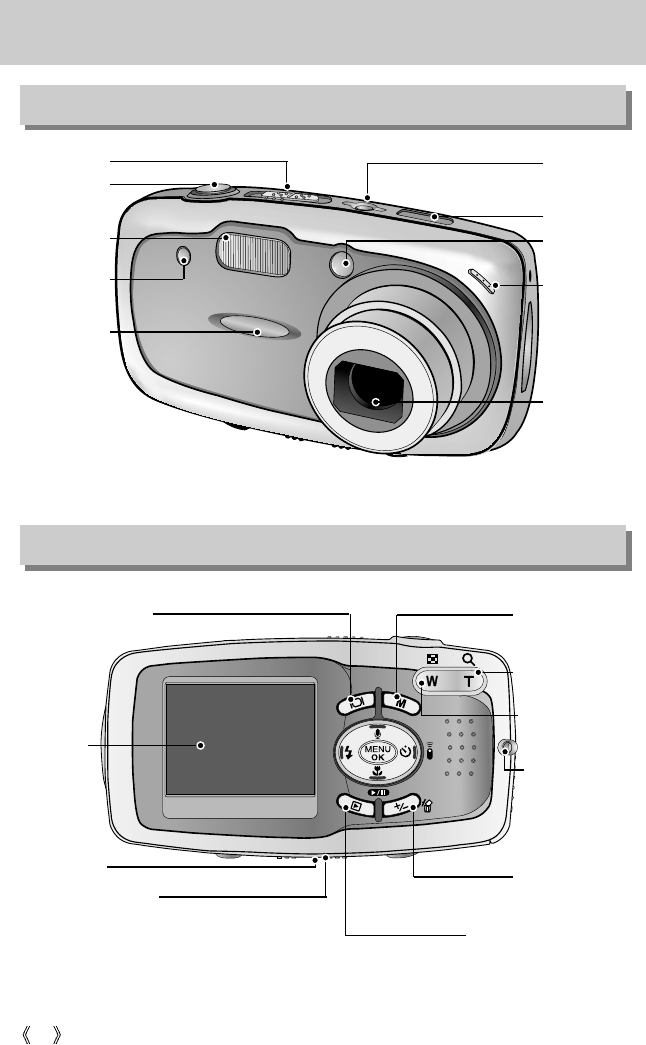
10
Identification of features
Front & Top
Back & Bottom
Flash
Remote
control sensor
Lens
Power button
Auto Focus lamp
Speaker
Microphone
Shutter button
Mode switch
LCD
monitor
LCD button
Strap eyelet
Zoom T button
(Digital zoom)
Zoom W button
(Thumbnail)
Play mode button
Tripod socket
DC/USB/AV
connection terminal/
Cradle connector
+/-, DELETE
button
M button
(Album button)
Function lamp &
Self-timer lamp
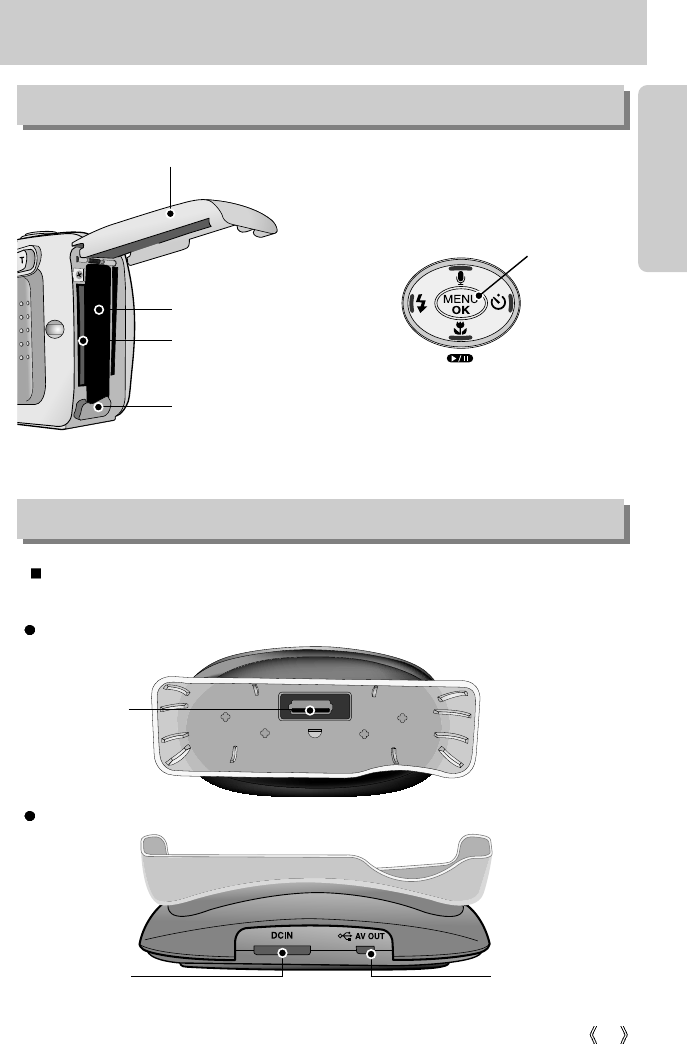
11
Identification of features
Front
Top
You can recharge your rechargeable battery, print a captured image and download images
with the cradle. (Refer to page 00 and 00)
Battery holder
Memory card slot
Battery chamber
Battery chamber cover
FLASH/
LEFT button
MENU/ OK button
Macro / DOWN button
Play & Pause button
SELF-TIMER/
RIGHT button
Voice memo/ UP button
Side/ 5-function button
Cradle
Camera connection
terminal
USB port
AV connection terminal
DC input
connection point
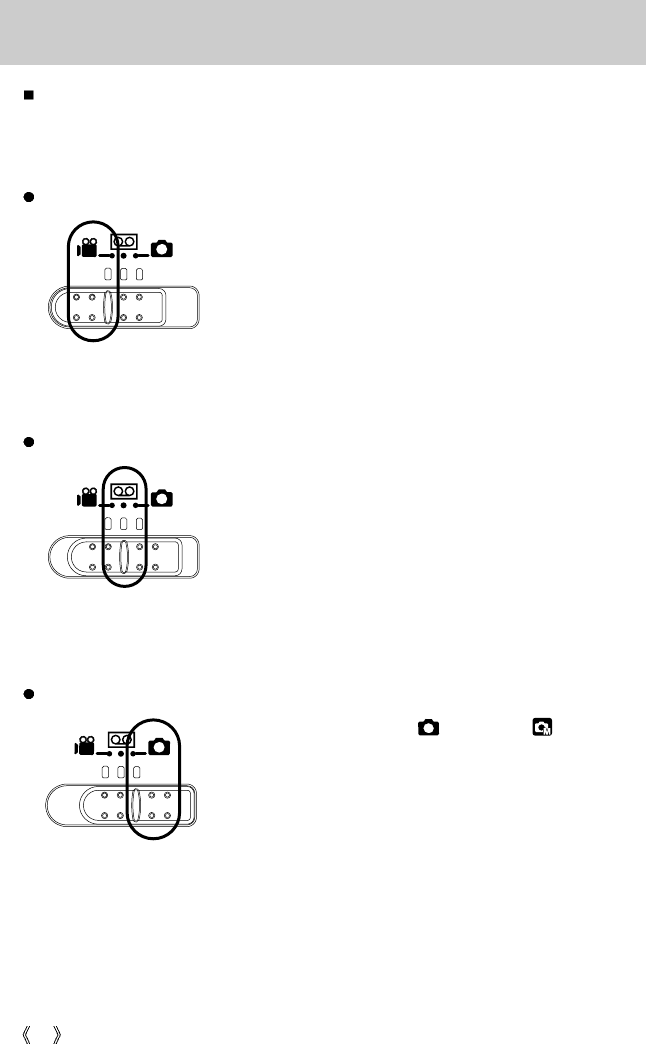
12
Identification of features
Still image mode
You can select from AUTO( ), MANUAL( ) or
SCENE mode. In SCENE mode, you can select the NIGHT,
PORTRAIT, CHILDREN, LANDSCAPE, CLOSE UP, TEXT
RECOGNITION, SUNSET, DAWN, BACKLIGH,
FIREWORKS and BEACH&SNOW scene menu.
Voice recording mode
A movie clip can be recorded for as long as the available
recording time of the memory capacity allows.
Image size and type are listed below.
- Image size : 640X480, 320X240, 160X128 (user selectable)
- Movie clip file type : *. avi(MJPEG-4)
A voice recording can be recorded for as long as the available
recording time of the memory capacity allows. (Max: 1 hour)
- File type : *.wav
Movie clip mode
You can select the desired working mode by using the mode switch located on the top of the
camera. This digital camera has 3 recording modes. These are listed below.
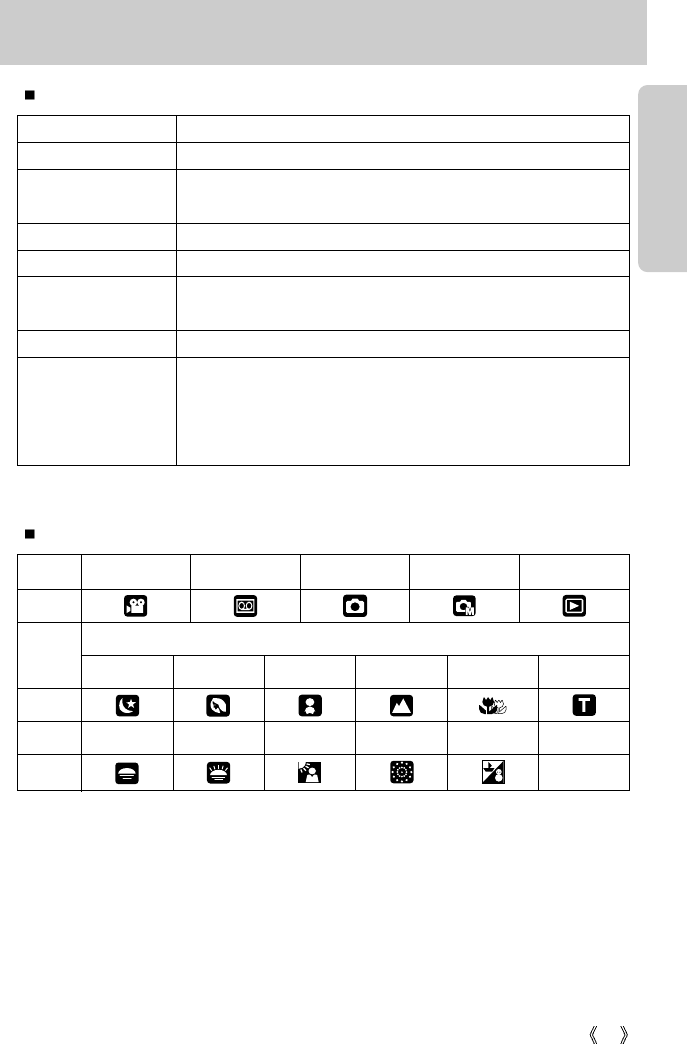
13
Identification of features
Mode icons
Function lamp & Self-timer lamp
Function Description
Power on The lamp blinks and turns off when the camera is ready to take a picture
The lamp blinks while saving the image data and turns off when the
camera is ready to take a picture
While movie recording The lamp blinks at a 1-second interval
While voice recording The lamp blinks at a 1-second interval
The lamp lights up
Transmitting Data The lamp blinks
For the first 7 seconds, the lamp blinks at 1 second intervals.
For the final 3 seconds, the lamp blinks quickly at 0.25 second intervals.
* The lamp will function while using the self-timer even if the configuration
is set to off the lamp. (Based on 10-second Self-timer; see p. 36)
While the
self timer is functioning
When the USB cable is
inserted
After taking a picture
MODE MOVIE CLIP
VOICE RECORDING
AUTO MANUAL PLAY
ICON
NIGHT PORTRAIT CHILDREN
LANDSCAPE
CLOSE UP TEXT
ICON
MODE SUNSET DAWN BACKLIGHT
FIREWORKS
BEACH&SNOW
-
ICON -
MODE
SCENE
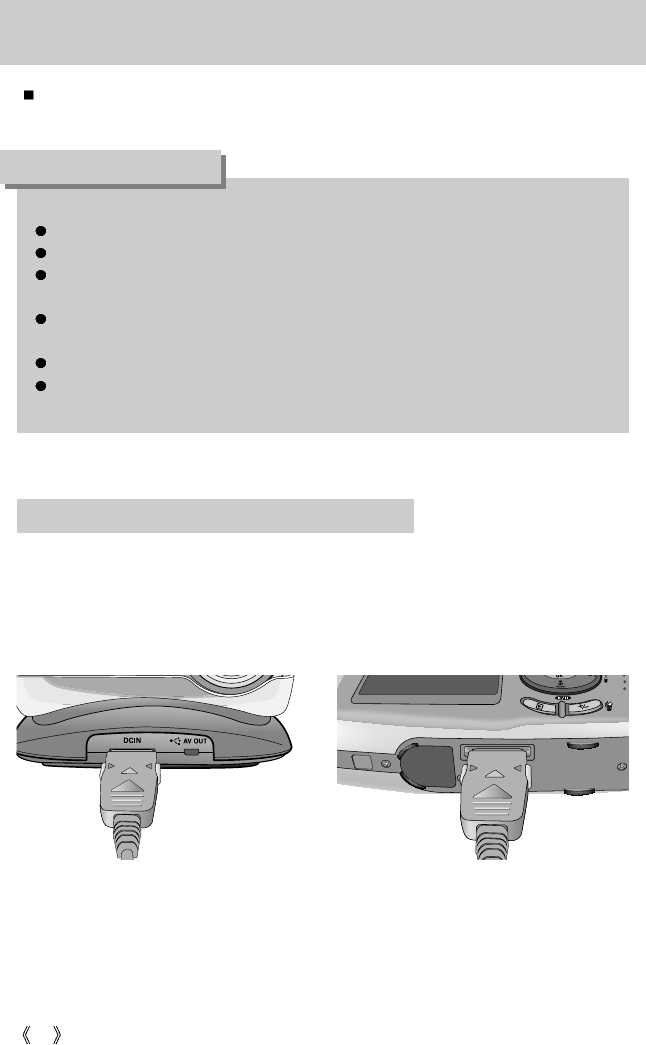
14
Connecting to a Power Source
If you have access to a mains supply, using an SAC-41 (for both Charger and AC adapter)
allows the camera to be used for long periods of time.Plug the SAC-41 (for both Charger and
AC adapter) into the connection point (DC IN 4.2V) on the camera.
* Insert the rechargeable batteries when using an AC adapter.
Using the SAC-41(for both Charger and AC adapter)
[Using the AC adapter with Cradle] [Using the AC adapter with Camera]
Important information about battery usage
When the camera is not used, turn off the camera power.
Do not use the non rechargeable batteries. It may cause an explosion.
Please remove the batteries if the camera will not be used for long periods.
Batteries can lose power over time and are prone to leaking if kept inside the camera.
Low temperatures (below 0°C) can affect the performance of the batteries and you may
experience reduced battery life.
Batteries will usually recover at normal temperatures.
During extended use of the camera, the camera body may become warm.
This is perfectly normal.
INFORMATION
You should use the rechargeable battery (SLB-1137) supplied with the camera. Do not use
the AC adapter and non rechargeable battery at the same time. It may cause an explosion.
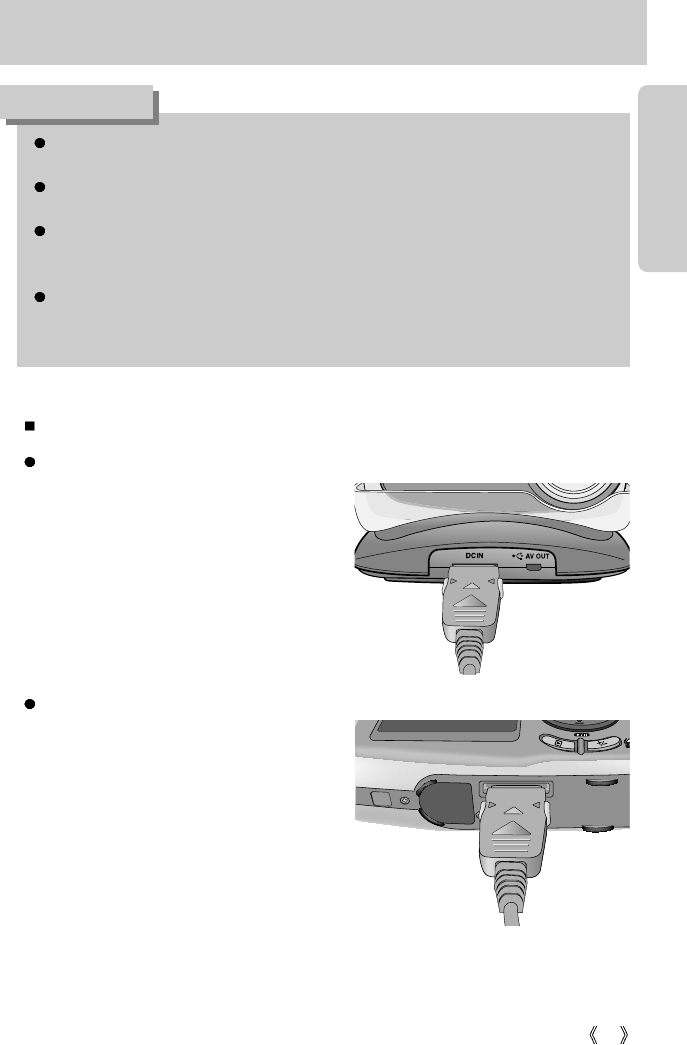
15
Connecting to a Power Source
Charging with the camera
- Insert the rechargeable battery into the
battery chamber.
- Put the SAC-41 (for both Charger and AC
adapter) into the socket and DC input
connection point of the camera.
Always turn off the power before taking the SAC-41 (for both Charger and AC adapter)
out of the mains supply.
As with all mains powered devices, safety is important. Ensure that neither the camera
nor adapter comes into contact with water or metallic materials.
Please ensure that you use the SAC-41 (for both Charger and AC adapter) or TTA
standardized chargers with the correct specification for the camera. Failure to do so may
affect your warranty.
Do not use the flash frequently or take many pictures with the fully discharged
rechargeable battery charged for a short time. Even if the charger is inserted, the camera
power may be turned off because the rechargeable battery is discharged again.
DANGER
Charging with the cradle
- Insert the rechargeable battery into the
battery chamber.
- Place the camera correctly in the cradle.
- Put the SAC-41 (for both Charger and AC
adapter) into your power socket and DC
input connection point of the camera.
How to charge the rechargeable battery (SLB-1137)
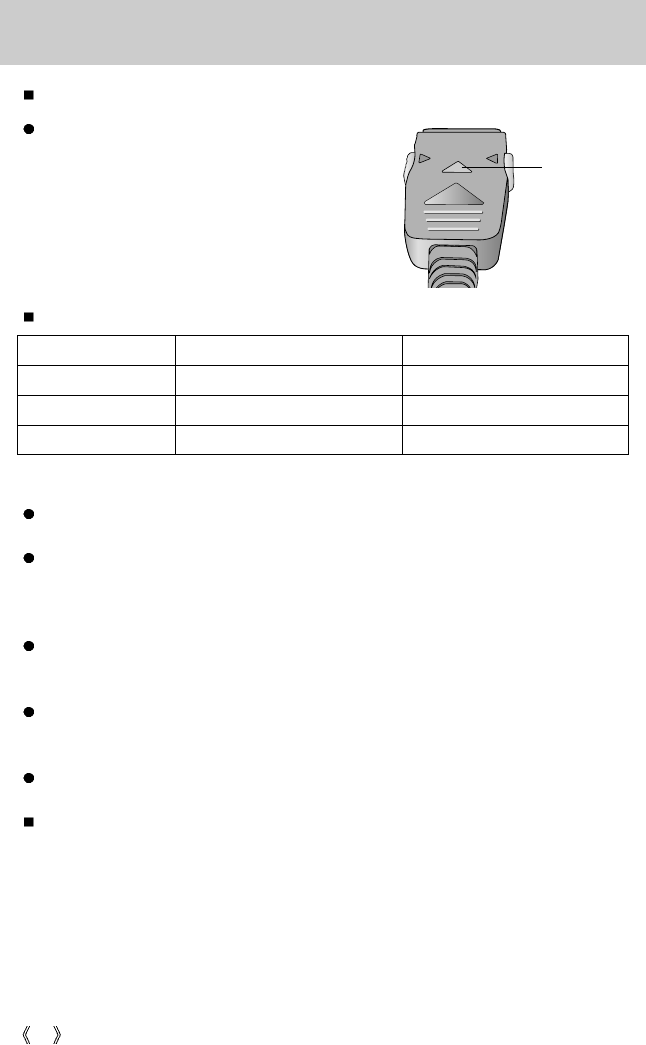
16
Connecting to a Power Source
If the charging LED of the SAC-41 does not turn
on or blink after inserting the rechargeable battery,
please check whether the batteries are inserted
correctly.
Important information about battery (SLB-1137) charging
Charging LED
If there is a charging error, please check all the power connections are in place.
All of the chargers (24 pin) have been tested in accordance with TTA (Telecommunication
Technology Association) can be used as AC adapter. We recommend the SAC-41(for both
Charger and AC adapter). Failure to do so may affect your warranty.
You can charge the battery with a USB charging cable(TTA standardized 24 pin cable) by
connecting a PC, but the charging time will be longer than using SAC-41. (About 3 hours)
If you use the USB charging cable (TTA standardized 24 pin cable) as a power cable, please
insert the SLB-1137 rechargeable battery first.
The USB charging cable (TTA standardized 24 pin cable) is optional.
Charging time (When the camera is turned off)
- Using the cradle : About 150MIN
- Using the SAC-41 : About 150MIN
- Using the USB charging cable (TTA standardized 24 pin cable) : About 180MIN or longer.
(The charging time may vary depending on the manufacturers.)
Status Using the cradle Direct to the camera
Being Charged Red LED is on Red LED is on
Charging is complete Green LED is on Green LED is on
Charging error Red LED is off or blinking Red LED is off or blinking
Charging
LED
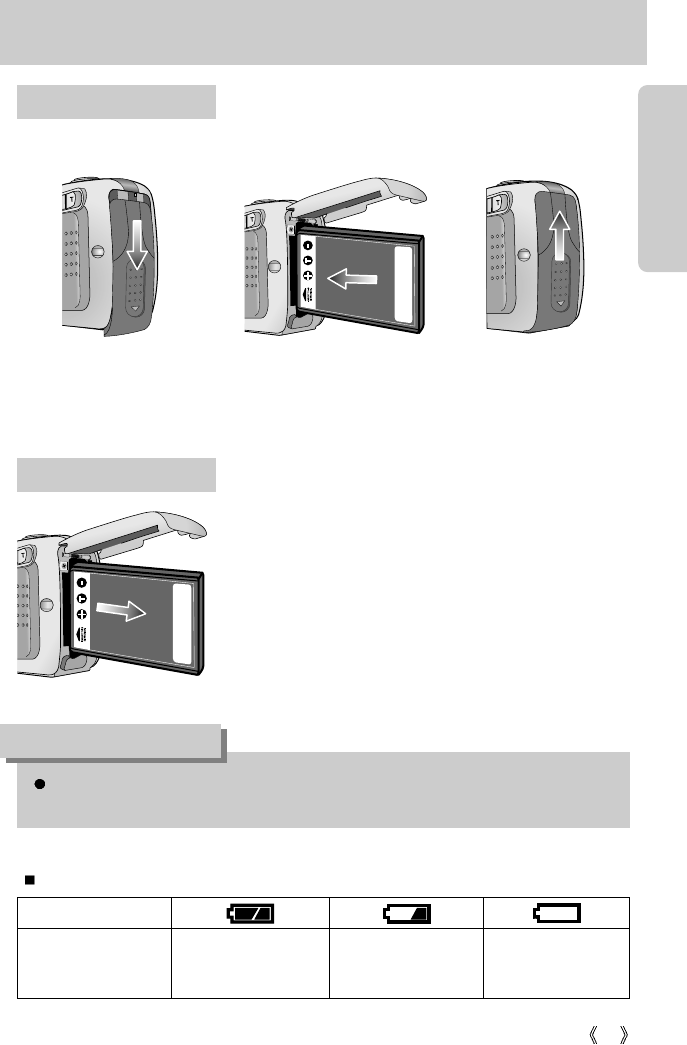
17
Connecting to a Power Source
Using the batteries :
If the camera does not turn on after you have inserted batteries,
please check whether the batteries are inserted with the correct
polarity(+/-).
1. Open the battery chamber
cover by pushing in the
direction of the arrow.
2. Insert the batteries taking
note of the polarity (+ / -).
3. To close the battery
chamber cover, push it
until it clicks.
Battery status
Battery indicator
The batteries are fully
charged Prepare new batteries
There is no battery capacity.
Replace with new batteries.
There are 3 indicators for battery condition that are displayed on the LCD monitor.
Removing the battery
1. Turn off the camera power. Open the battery chamber
cover and move the battery holder aside. The battery will
be released.
2. Take out the battery and close the battery chamber cover.
When the battery chamber cover is opened, do not press the battery chamber cover by
force. This may cause the battery chamber cover modification or breakage.
INFORMATION

18
Instructions on how to use the memory card
Be sure to format the memory card (see p.72) if you are using a newly purchased memory for
the first time, if it contains data that the camera cannot recognise, or if it contains images
captured with a different camera.
Turn off the camera power whenever the memory card is being inserted or removed.
Repeated use of the memory card will eventually reduce the memory card’s performance.
Should this be the case, you will need to purchase a new memory card.
Wear and tear on the memory card is not covered by the Samsung warranty.
The memory card is an electronic precision device.
Do not bend, drop or subject the memory card to any heavy impact.
Do not store the memory card in an environment with strong electronic or magnetic fields,
e.g. near loud speakers or TV receivers.
Please do not use or store in an environment where there are extremes in temperature.
Do not allow the memory card to become dirty or to come into contact with any liquid.
Should this happen, clean the memory card with a soft cloth.
Please keep the memory card in its case when not in use.
During and after periods of extended use, you may notice that the memory card is warm.
This is perfectly normal.
Do not use a memory card that is used in another digital camera.
To use the memory card in this camera, format first the memory card by using this camera.
Do not use a memory card formatted by another digital camera or memory card reader.
Maintenance of the memory card
Preserving the memory card data
If the memory card is subjected to any of the following, the recorded data may become
corrupted :
- When the memory card is used incorrectly.
- If the power is switched off or the memory card is removed while recording, deleting
(formatting) or reading.
Samsung cannot be held responsible for lost data.
It is advisable to copy important data onto other media as back-up e.g. floppy disks, hard
disks, CD etc.
If there is insufficient memory available : If you press the shutter button for the shot, a
[Card Full !] message will appear and the camera will not operate. To optimise the amount of
memory in the camera, replace the memory card or delete unnecessary images stored on
the memory.
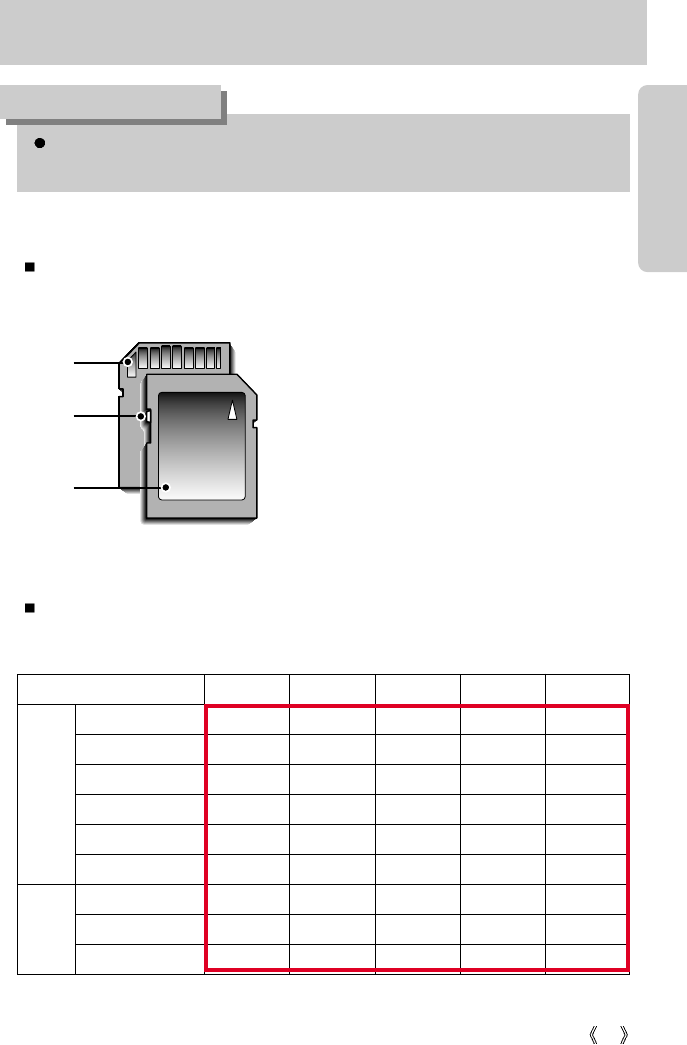
19
Instructions on how to use the memory card
Don't remove the memory card when the function lamp is blinking as this may cause
damage to data in the memory card.
INFORMATION
[ SD (Secure Digital) memory card ]
Write
protect
switch
Label
Card
pins
The camera can use SD Memory Cards and MMC (Multi Media Cards). Please consult the
enclosed manual for using the MMC Cards.
The SD memory card has a write protect switch
that prevents image files from being deleted or
formatted. By sliding the switch to the bottom of
the SD memory card, the data will be protected.
By sliding the switch to the top of the SD
memory card, the data protection will be
cancelled. Slide the switch to the top of the SD
memory card before taking a picture.
When using a 32MB SD memory card, the specified shooting capacity will be as follows.
These figures are approximate as image capacities can be affected by variables such as
subject matter.
Recorded image size S. Fine Fine Normal 30FPS 15FPS
2592X1944 9 18 29 - -
2272X1704 10 24 38 - -
2048X1536 16 36 58 - -
1600X1200 36 67 117 - -
1024X768 36 67 117 - -
640X480 72 121 214 - -
640X480 - - - 35SEC 20SEC
320X240 - - -
1MIN 25SEC
44SEC
160X128 - - -
1MIN 25SEC
44SEC
Still
image
Movie
clip
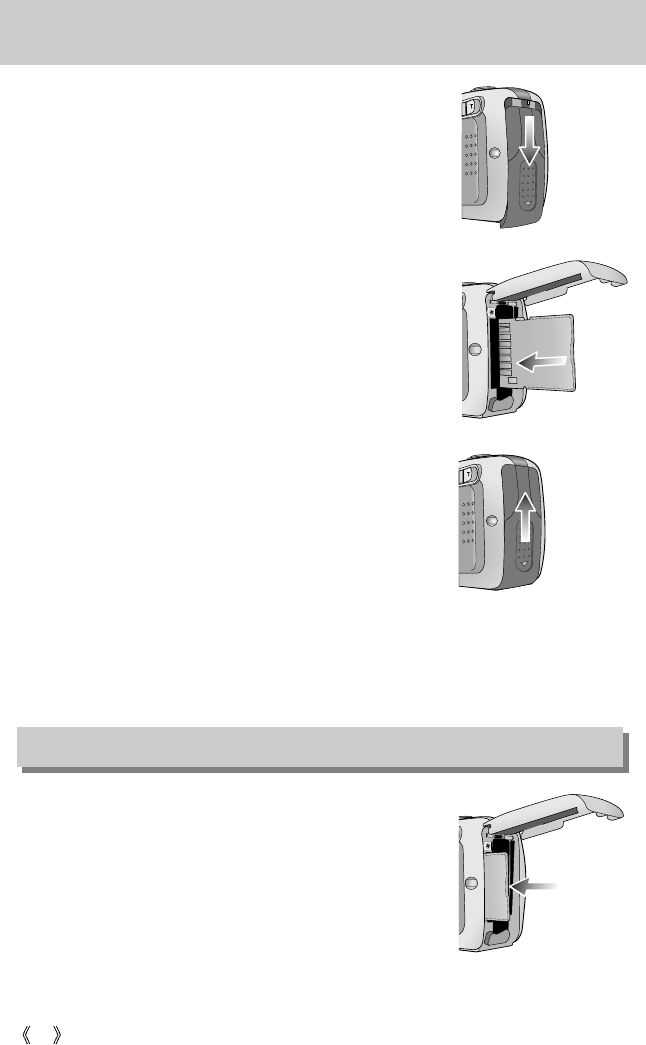
20
Inserting the memory card
3. To close, push the battery chamber cover until you hear
a click. If the memory card does not slide in smoothly,
do not attempt to insert it by force. Check the direction of
insertion, and then insert it correctly. Do not insert the
memory card the wrong way round. Doing so may
damage the memory card slot.
2. Have the front of the memory card facing toward the
front ofthe camera (lens) and the card pins toward the
back of the camera (LCD monitor), and then push the
memory card into the card slot until you hear a click.
1. Turn off the camera’s power and pull the battery
chamber cover in the direction of the arrow to open.
1. Turn the power off using the power button.
Open the battery chamber cover and press the memory
card as shown in the image and release.
2. Remove the memory card and close the battery
chamber cover.
Removing the memory card
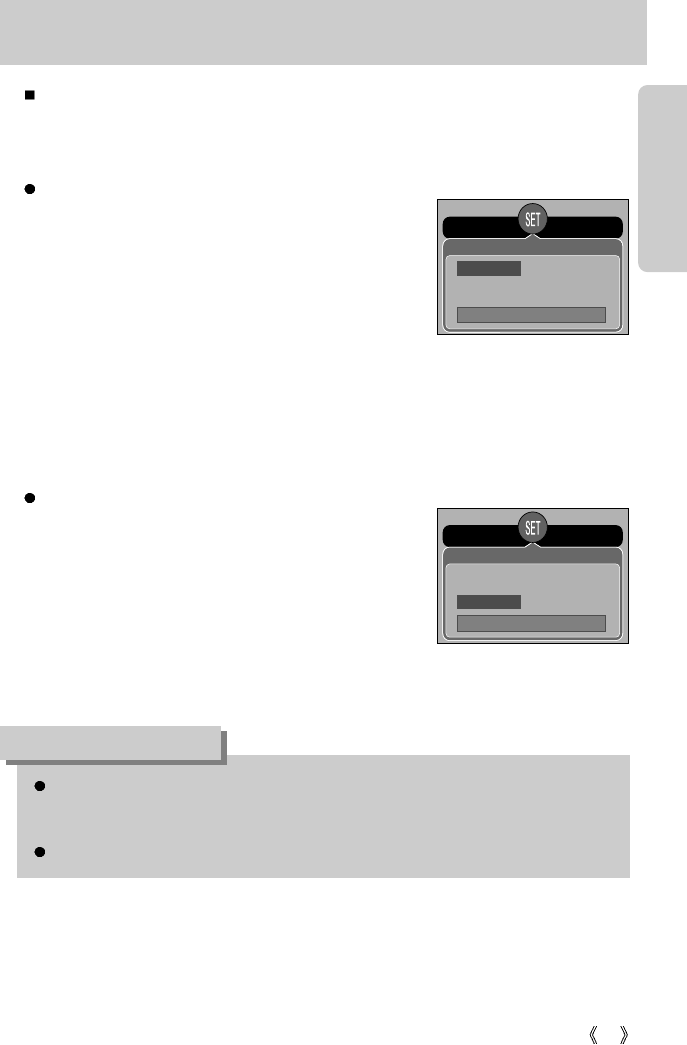
21
When Using the Camera for the First Time
If the camera is turned on for the first time, a menu will be displayed to set date, time and
language in the LCD monitor. This menu will not be displayed after setting up the date, time
and language. Set up the date, time and language before using this camera.
Setting up the date, time and date type
1. Select the [D & Time] menu by pressing the UP/DOWN
button and press the RIGHT button.
2. Select the desired sub menu by pressing the UP/
DOWN/ LEFT/ RIGHT button.
RIGHT button : selects YEAR/ MONTH/ DAY/
HOUR / MINUTE/DATE TYPE
LEFT button : Moves the cursor to the [D & Time]
main menu if the cursor is at the
first item of the date and time setup. In all other instances, the cursor
will be shifted to the left of its current position.
UP/ DOWN button : changes the value of each item.
You can select 18 languages. These are listed below
: English, Korean, French, German, Spanish, Italian, S. Chinese, T. Chinese, Japanese,
Russian, Portuguese, Dutch, Danish, Swedish, Finnish, Thai, Malaysian and Arabic.
Even if the camera is restarted, the language setting will be maintained.
INFORMATION
Setting up the language
1. Select the [Language] menu by pressing the UP/DOWN
button and press the RIGHT button.
2. Select the desired sub menu by pressing the UP/
DOWN button and press the OK button.
When the settings are complete, press the MENU
button twice to exit the menu screen.
Setup
D&TIME 05/ 01/ 01
Language English
Move : Set : OK
Setup
D&TIME 05/ 01/ 01
Language English
Move : Set : OK
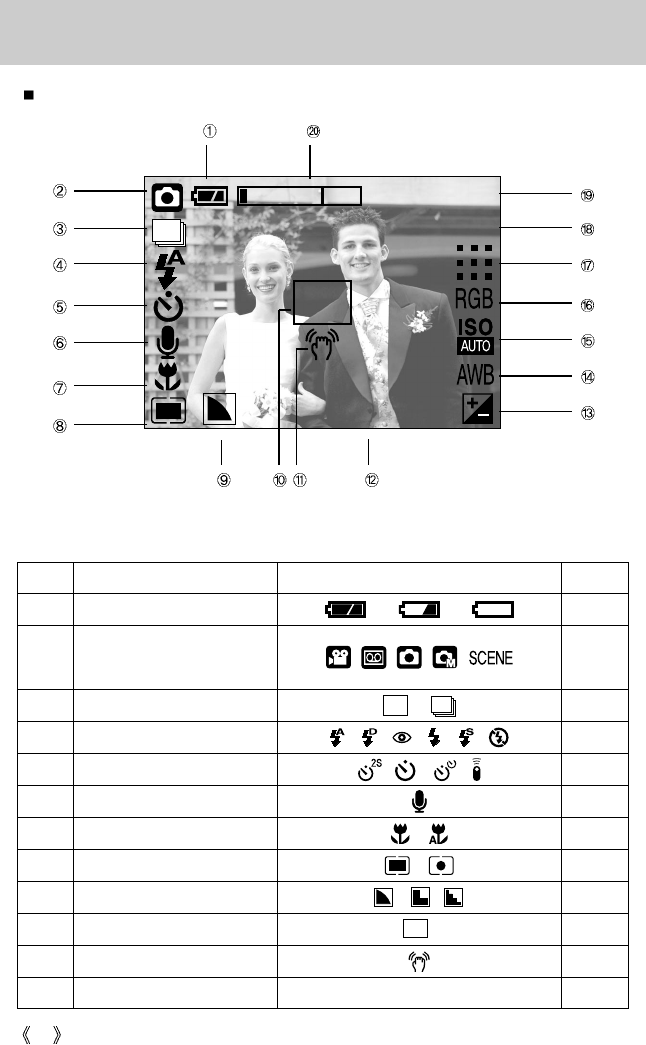
22
LCD monitor indicator
The LCD monitor displays information about the shooting functions and selections.
[Image & Full Status]
15
2592
01:00 PM
2005/01/01
No. Description Icons Page
1
Battery
p.15
3
Continuous shot
4
Flash
p.34
5
Self-timer
p.36
6
Voice memo
p.31
7
Macro
p.32
8
Metering
p.50
9
Sharpness
p.51
10
Auto focus frame
11
Camera shake warning
12
Date/ Time
2005/01/01 01:00 PM
Recording mode
2
p.12~13
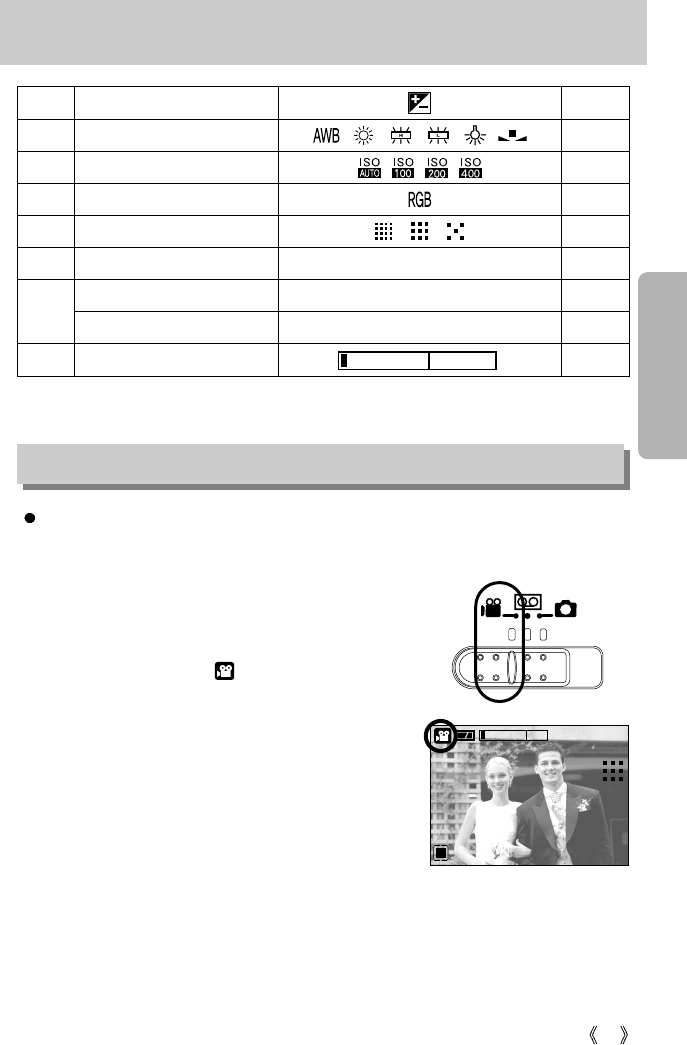
23
LCD monitor indicator
Starting the recording mode
Recording a Movie clip
1. Insert the batteries (p.15). Insert the batteries taking note of the polarity (+ / -).
2. Insert the memory card (p.18).
3. Close the battery chamber cover.
4. Press the power button to turn on the camera.
(If the date/time that is displayed on the LCD monitor is
incorrect, reset the date/time before taking a picture.)
5. Select the MOVIE CLIP( ) mode by sliding the mode
switch.
6. Point the camera towards the subject and compose the
image by using the LCD monitor.
7. Press the shutter button to take a movie clip.
Press the shutter button once and movie clips are
recorded for as long as the available recording time
allows. Movie clips will still be recorded if the shutter
button is released. If you wish to stop recording, press
the shutter button again.
Image size and type are listed below.
- Image size: 640X480, 320X240, 160X128 (Selectable)
- File type : *. avi(MJPEG-4)
00:00:29
640
[ MOVIE CLIP mode ]
13
Exposure compensation
p.39
14
White Balance
p.40
15 ISO p.41
16 RGB p.51
17
Image quality
p.49
18
Image size
2592, 2272, 2048, 1600, 1024, 640 p.48
Number of available shots remaining
15
Remaining time (Movie clip/ Voice recording)
00:01:30/ 01:00:00
20
Optical/ Digital zoom bar
19
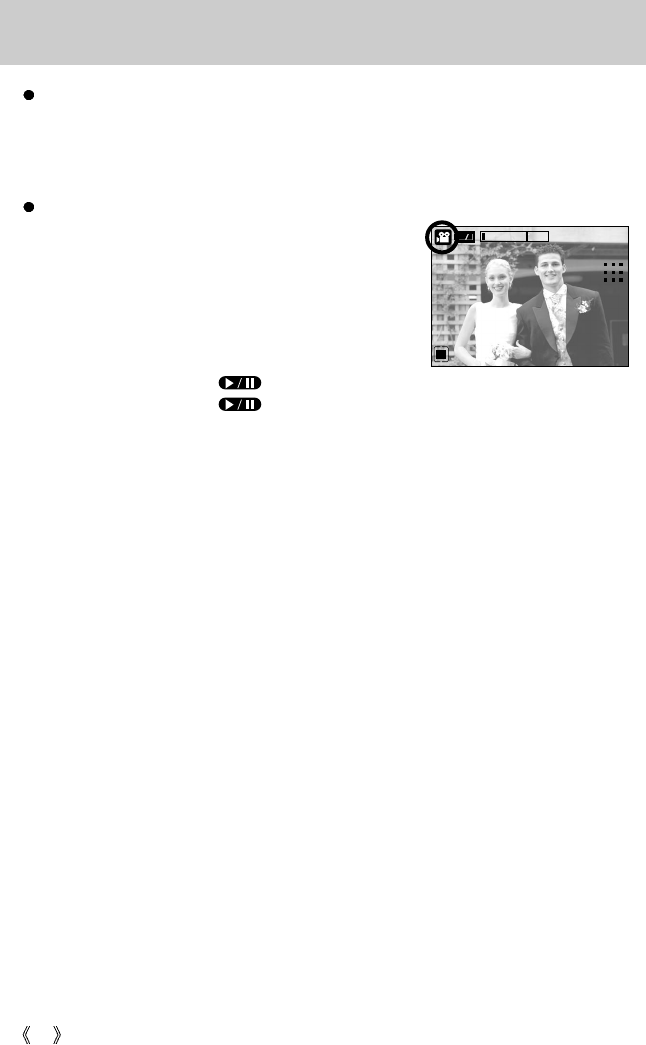
24
Starting the recording mode
Pausing while recording a movie clip (Successive Recording)
This camera allows you to temporarily stop during unwanted scenes, while recording a movie
clip. Using this function, you can record your favourite scenes into a movie clip without having
to create multiple movie clips.
Using Successive Recording
Steps from 1-6 are the same as those for MOVIE CLIP
mode.
7. Point the camera towards the subject and compose the
image by using the LCD monitor. Press the shutter
button and movie clips are recorded for as long as the
available recording time. Movie clips will still be recorded
if the shutter button is released.
8. Press the Pause button ( ) to pause recording.
9. Press the Pause button ( ) again to resume the
recording.
10. If you wish to stop recording, press the shutter button again.
00:00:29
640
[Successive recording of a movie clip]
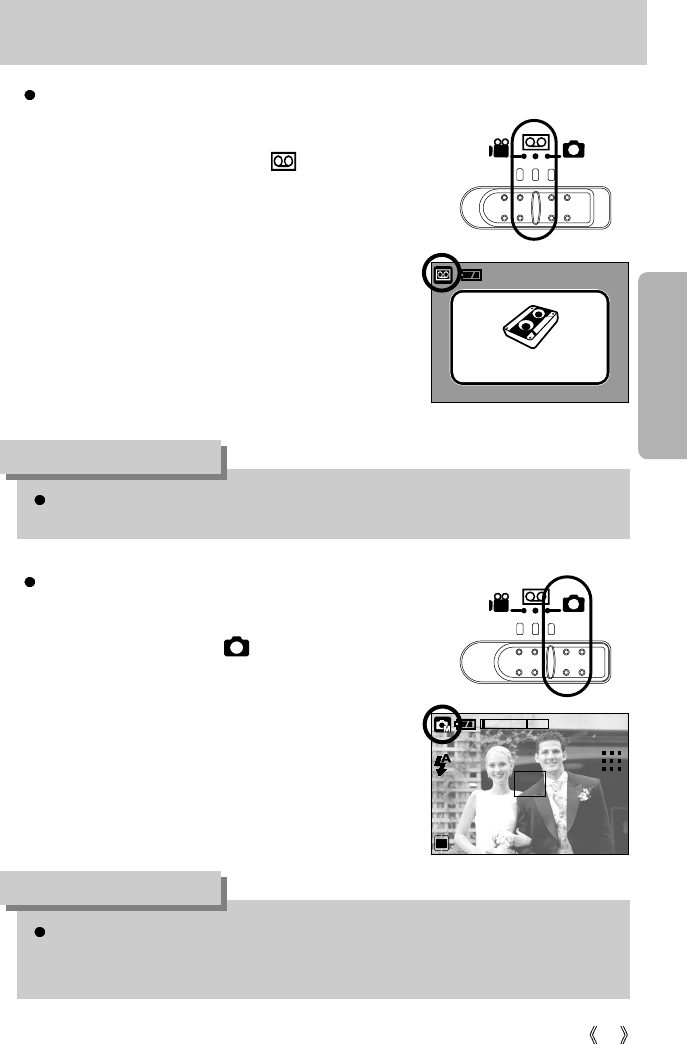
25
Starting the recording mode
Recording a still image
Steps from 1-4 are the same as those for recording a
movie clip.
5. Select the STILL IMAGE( ) mode by sliding the
mode switch.
6. Point the camera towards the subject and compose the
image by using the LCD monitor.
7. Press the shutter button to capture an image.
15
2592
01:00 PM
2005/01/01
If the auto focus frame turns to red when you press the shutter button down half way, it
means that the camera cannot focus on the subject. Should this be the case, the camera
is unable to capture an image clearly.
INFORMATION
A distance of 40cm between you and the camera (microphone) is the best distance to
record sound.
INFORMATION
Recording Voice
Steps from 1-4 are the same as those for recording a
movie clip.
5. Select the VOICE RECORDING( ) mode by
sliding the mode switch.
6. Press the shutter button to record a voice.
- Press the shutter button once and voice is recorded for
as long as the available recording time(Max : 1 hour)
allows. The recording time will be displayed on the
LCD monitor.
- Voice will still be recorded if the shutter button is
released.
- If you wish to stop recording, press the shutter button
again.
- File type : *.wav
01:04:33
[ VOICE RECORDING mode ]
[ Still image mode ]
Start:Shutter
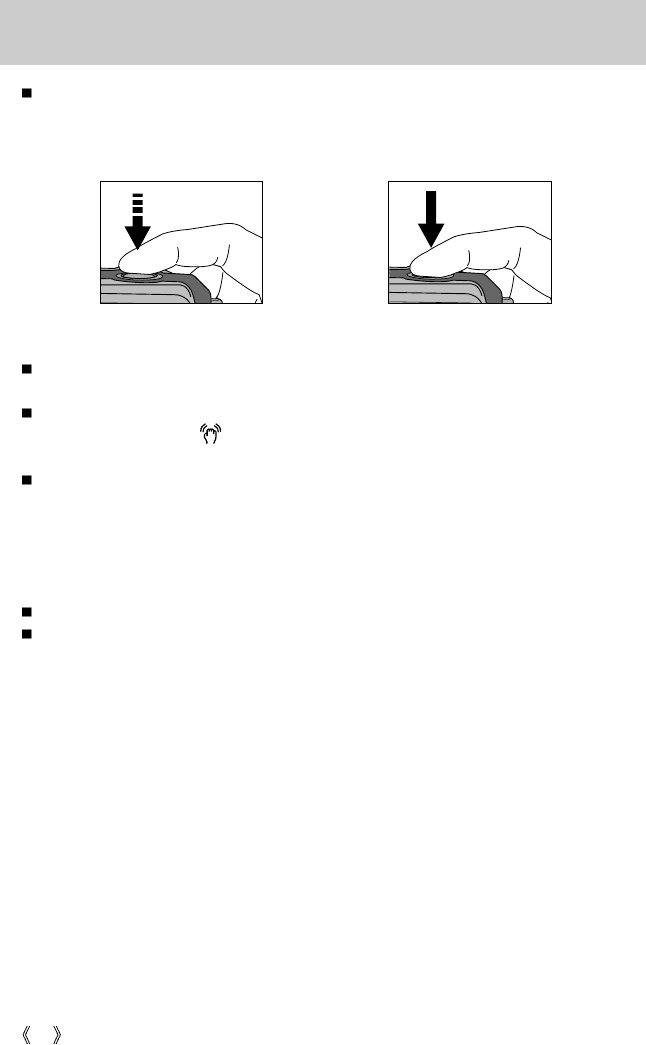
26
Things to Watch Out for When Taking Pictures
Pressing the shutter button down half way
Lightly press the shutter button to confirm focus and flash battery charge.
Press the shutter button all way down to take the picture.
The available recording time may vary depending on shooting conditions and camera
settings.
When the Flash Off or Slow synchro mode is selected in a low lighting condition, the camera
shake warning indicator ( ) may appear on the LCD monitor. In this case, use a tripod,
support the camera on a solid surface or change the flash mode to flash shot mode.
Backlight compensated shots : When taking an outdoor shot, avoid facing the sun, as the
image may be dark because of the strong backlight.
To take a picture against the sun, please use the [Backlight] in
the scene shooting mode (see page 50), Fill-in flash (see page
32), Spot metering (see page 46), or Exposure compensation
(see page 38).
Avoid obstructing the lens or the flash when you capture an image.
As there can be some differences between what is seen through the Viewfinder and the
resulting image when taken at a range closer than 1.5m, it is recommended that you use the
LCD monitor to compose these shots.
- When photographing a subject that has little contrast.
- If the subject is highly reflective or shiny.
- If the subject is moving at high speed.
- When there is strong reflected light, or when the background is very bright.
- When the subject matter has only horizontal lines or the subject is very narrow
(such as a stick or flagpole).
- When the surroundings are dark
[ Lightly press the shutter button ] [ Press the shutter button ]
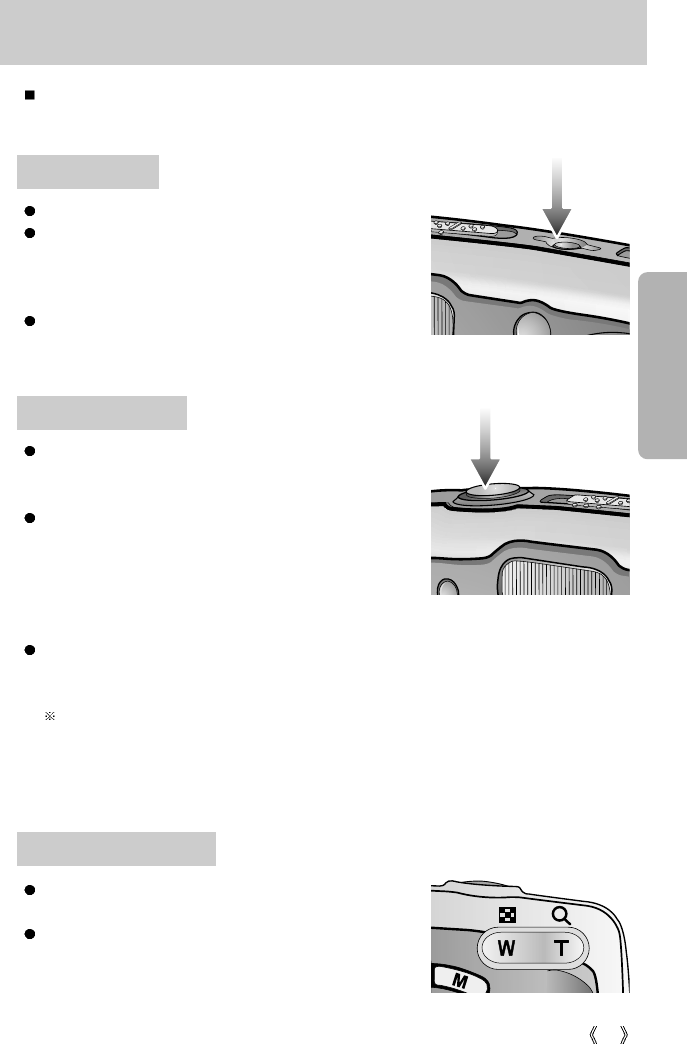
27
Using the camera buttons to adjust the camera
The RECORDING(STILL IMAGE, VOICE RECORDING, MOVIE CLIP) mode function can
be set up by using the camera buttons.
POWER button
SHUTTER button
If the menu is not displayed, this button works as the
OPTICAL ZOOM or DIGITAL ZOOM button.
If the menu is displayed in Still Image mode, pressing the
ZOOM W/T button will skip 5 menu tabs at a time.
ZOOM W/T button
Used for turning the camera’s power on / off.
If there is no operation during the specified time, the
camera's power will be turned off automatically to save
battery life. Refer to page 70 for more information about the
auto power off function.
Pressing the power button for over 3 seconds will
deactivate the start-up sound and sound function.
Used for taking an image or recording voice in the
RECORDING (STILL IMAGE, VOICE RECORDING,
MOVIE CLIP) mode.
In MOVIE CLIP mode
Pressing the shutter button down fully starts the process for
recording a movie clip. Press the shutter button once and
the movie clip is recorded for as long as the available
recording time in the memory allows. If you wish to stop
recording, press the shutter button again.
In STILL IMAGE mode
Pressing the shutter button down halfway activates the autofocus and checks the condition of
the flash.
When the flash is charging, a flash mode icon (red colour) will blink on the LCD monitor.
Pressing the shutter down fully takes the image and stores the relevant data regarding the
shot. If you select voice memo recording, the recording will start after the camera has
finished storing the image data.
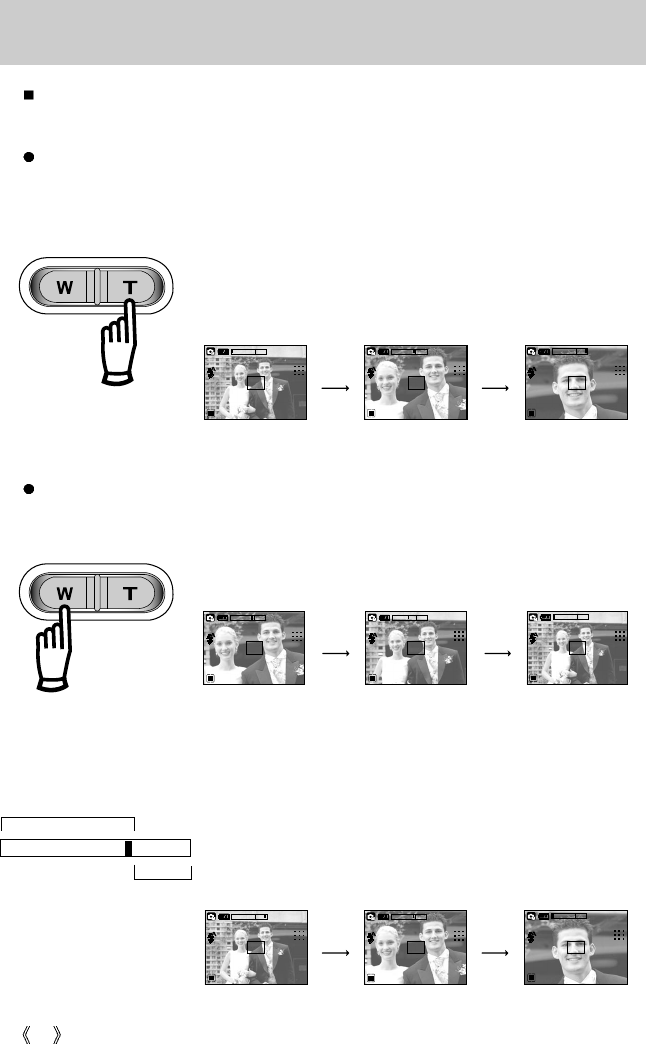
28
ZOOM W/ T button
This camera has a 3X optical zoom and a 5X digital zoom function. Using both will offer a
total zoom ratio of 15X.
TELE Zoom
Optical zoom TELE : Pressing the ZOOM T button. This will zoom into the subject i.e.
the subject will appear nearer.
Digital zoom TELE : When the maximum (3X) optical zoom is selected, pressing the
ZOOM T button activates the digital zoom software. Releasing
ZOOM T button stops the digital zooming at the required setting.
Once the maximum digital zoom (5X) is achieved, pressing the
ZOOM T button will have no effect.
15
2592
01:00 PM
2005/01/01
15
2592
01:00 PM
2005/01/01
15
2592
01:00 PM
2005/01/01
[ WIDE zoom ] [ TELE zoom ] [ Digital zoom 5.0X ]
Pressing the
ZOOM T button
Pressing the
ZOOM T button
WIDE Zoom
Optical zoom WIDE : Pressing the ZOOM W button. This will zoom out from the subject
i.e. the subject will appear further away. Pressing the ZOOM W
button continuously will set the camera to its minimum zoom
setting i.e. the subject appears at its furthest from the camera.
Digital zoom WIDE : When the digital zoom is in operation, pressing the ZOOM W
button will reduce the digital zooming in steps.
Releasing ZOOM W button stops digital zooming.
Pressing the ZOOM W button will reduce the digital zoom and
then it will continue to reduce the optical zoom until the minimum
setting is reached.
15
2592
01:00 PM
2005/01/01
15
2592
01:00 PM
2005/01/01
15
2592
01:00 PM
2005/01/01
[ TELE zoom ]
[ Optical zoom 2X ]
[ WIDE zoom ]
Pressing the
ZOOM W button
Pressing the
ZOOM W button
15
2592
01:00 PM
2005/01/01
15
2592
01:00 PM
2005/01/01
15
2592
01:00 PM
2005/01/01
[ Digital zoom 5.0X ] [ TELE zoom ] [ WIDE zoom ]
Pressing the
ZOOM W button
Pressing the
ZOOM W button
Optical zoom
Digital zoom
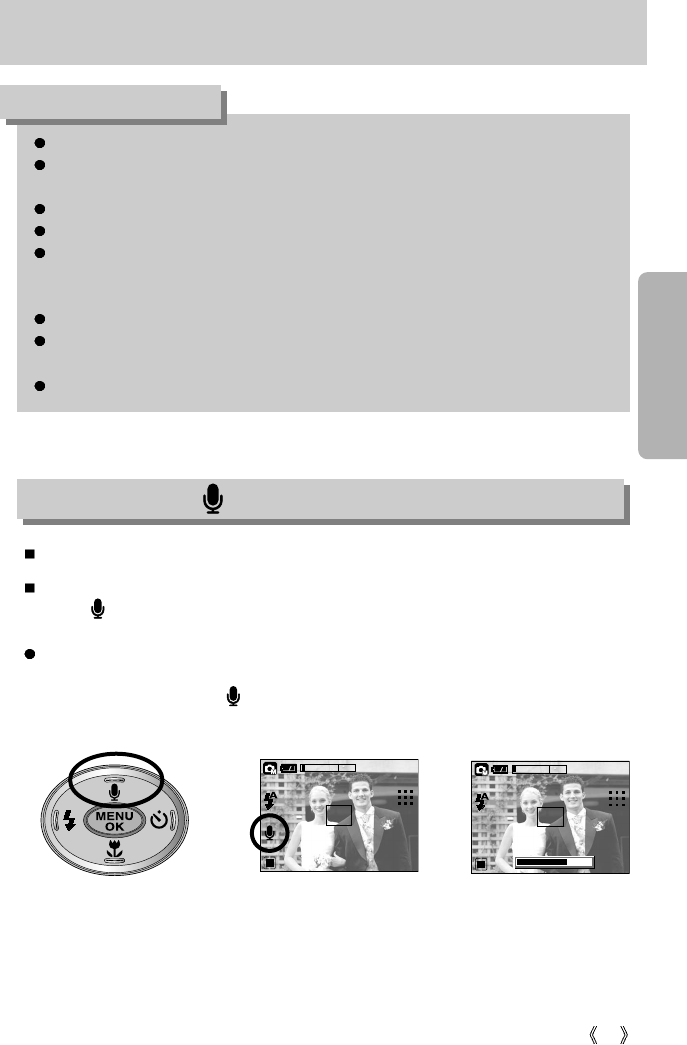
29
ZOOM W/ T button
To use the digital zoom the LCD monitor has to be turned on.
Images taken using the digital zoom may take a little longer for the camera to process.
Allow time for this to take place.
The digital zoom cannot be used in movie clip shots.
You may notice a decrease in image quality when using the digital zoom.
Take care not to touch the lens to avoid taking an unclear image and possibly causing
camera malfunction.
If the image is dim, turn the camera power off and on again to modify the lens position.
Take care not to press the lens as this may cause a camera malfunction.
When the camera is turned on, take care not to touch the camera’s moving lens parts as
this may cause the resulting image to be dim and unclear.
Take care not to touch the lens during zoom operation as this may cause damage.
INFORMATION
Voice memo( ) / UP button
While the menu is showing, press the UP button to move up the submenu cursor.
When the menu is not displayed on the LCD monitor, the UP button operates as the voice
memo( ) button. You can add your voice-over to a stored still image.
Recording a voice memo
1. Select the STILL IMAGE mode by sliding the mode switch.
2. Press the VOICE MEMO( ) button. If the voice memo indicator is displayed on the
LCD monitor, the setting is completed.
[ Recording Voice Memo ]
15
2592
[ Preparing for Voice Memo ]
15
2592
01:00 PM
2005/01/01
Stop:Shutter
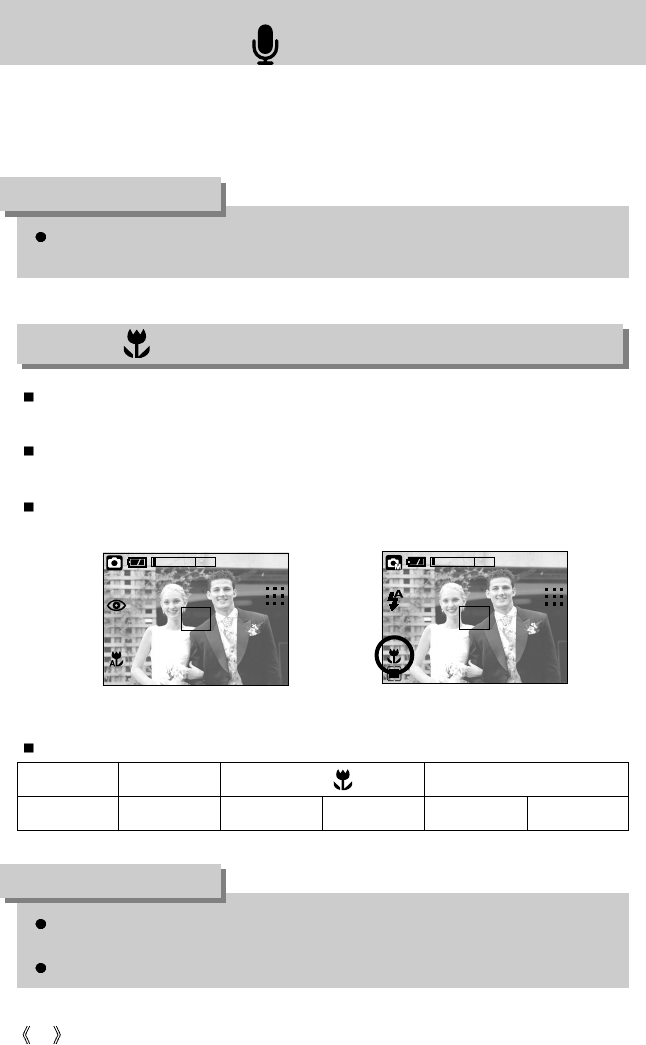
30
Voice memo( ) / UP button
3. Press the shutter button and take a picture. The picture is stored on the memory.
4. Voice memo will be recorded for ten seconds from the moment the picture is stored.
In the middle of the voice recording, pressing the shutter button will stop the voice memo.
A distance of 40cm between you and the camera (microphone) is the best distance to
record sound.
INFORMATION
When the macro mode is selected, it is possible that camera shake will occur.
If this is the case, use a tripod to eliminate this.
When you take a picture within 30cm(MACRO focus), select the FLASH OFF mode.
INFORMATION
While the menu is showing, press the DOWN button to move from the main menu to a
submenu, or to move down the submenu cursor.
When the menu is not showing, you can use the MACRO/ DOWN button to take macro
pictures (within the distance range of 5-80 cm).
The auto macro function will be activated automatically in the AUTO mode.
Types of focus modes and focus ranges (W: Wide, T: Tele) (Unit : cm)
Macro( ) / Down button
Focus type Auto
Focus range 80 ~ Infinity W : 5 ~ 80 T : 50 ~ 80 W : 5 ~ Infinity T : 50 ~ Infinity
15
2592
01:00 PM
2005/01/01
15
2592
01:00 PM
2005/01/01
[Auto macro]
[Macro]
Macro( ) Auto macro
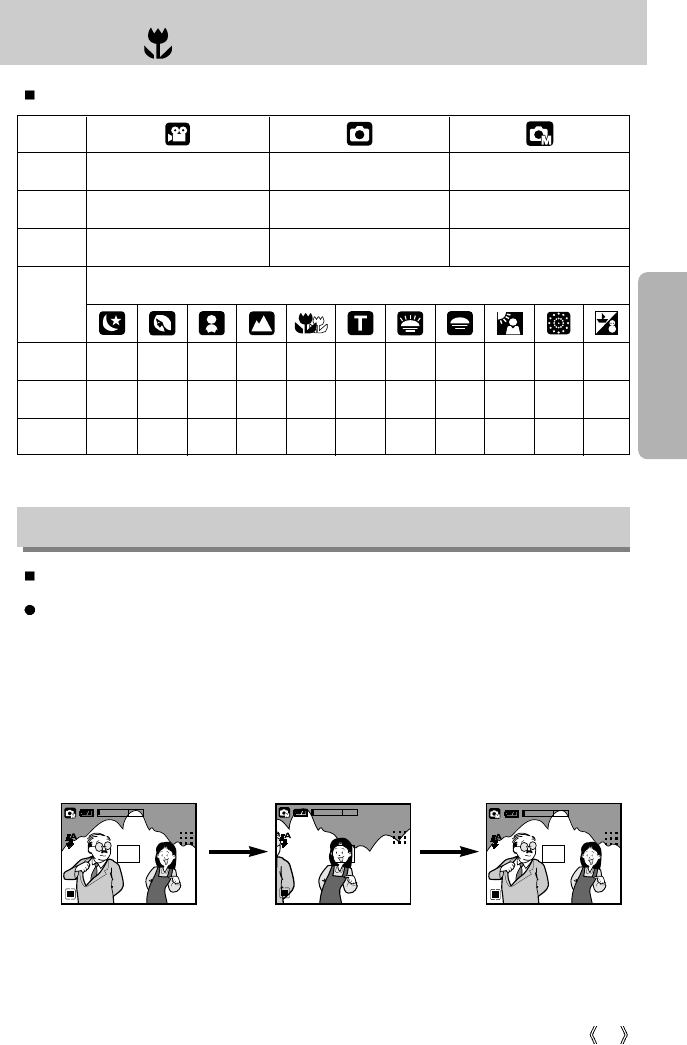
31
Macro( ) / Down button (Focusing)
Focus lock
To focus on the subject positioned outside of the centre, use the focus lock function.
Using the Focus Lock
1. Ensure the subject in the centre of the autofocus frame.
2. Press the SHUTTER button halfway. When the green auto focus frame lights up, it means
the camera is focused on the subject. Be careful not to press the SHUTTER button all the
way down to avoid taking an unwanted picture.
3. With the SHUTTER button still pressed down only halfway, move the camera to
recompose your picture as desired, and then press the SHUTTER button completely to
take the picture. If you release your finger from the SHUTTER button, the focus lock
function will be cancelled.
1. The image to be captured.
15
2592
01:00 PM
2005/01/01
2. Press the SHUTTER button
halfway and focus on the
subject.
15
2592
01:00 PM
2005/01/01
3. Recompose the picture
and fully depress the
SHUTTER button.
15
2592
01:00 PM
2005/01/01
Available focusing method, by recording mode
( O : Selectable , X : Not selectable, ∞: Infinity focus range)
OXO
OXO
XOX
SCENE
OOO∞XX∞∞O∞O
XXXXOXXXXXX
XXXXXOXXXXX
Mode
Auto
Macro
Auto macro
Auto
Macro
Auto macro
Mode
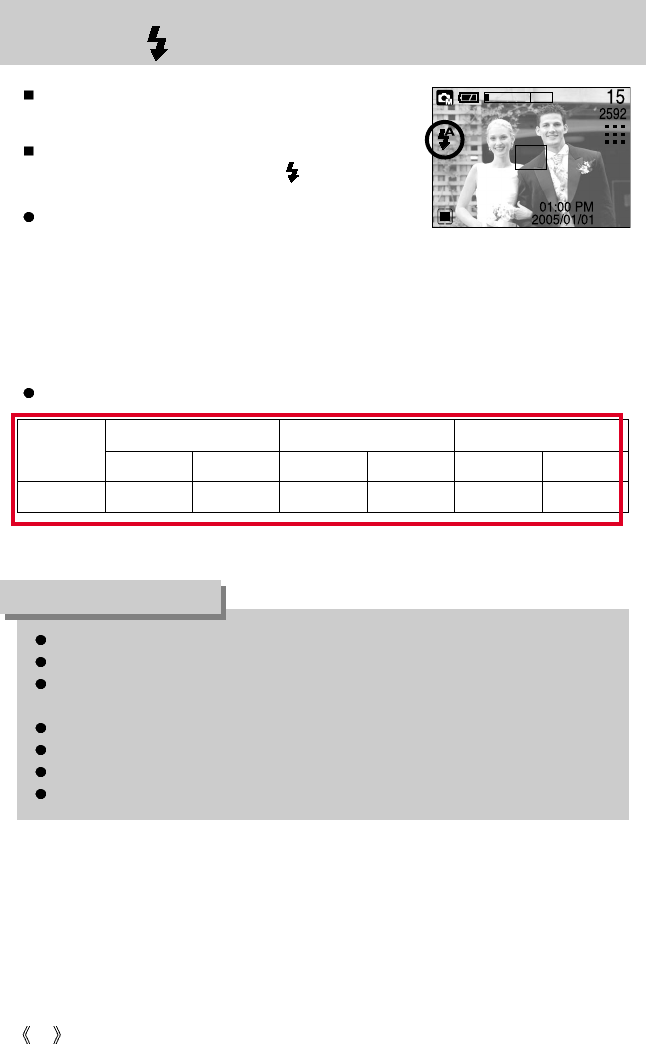
32
Flash ( ) / Left button
[ Selecting the Auto flash ]
Flash range (Unit : m)
When the menu is displayed on the LCD monitor, pressing
the LEFT button makes the cursor shift to the left tab.
When the menu is not displayed on the LCD monitor, the
LEFT button operates as the FLASH ( ) button.
Selecting the flash mode
1. Slide the mode switch to the STILL IMAGE mode.
2. Press the Flash button until the desired flash mode
indicator displays on the LCD monitor.
3. A flash mode indicator will be displayed on the LCD monitor. Use the correct flash to suit
the environment.
When the flash is charging, a flash mode icon (red colour) will blink on the LCD monitor.
Using the flash frequently will reduce the life of the batteries.
Under normal operating conditions the charging time for the flash is normally within 7
seconds. If the batteries are weak, the charging time will be longer.
During the continuous shot, movie clip mode, the flash function will not operate.
Take photographs within the flash range.
The image quality is not guaranteed if the subject is too close or highly reflective.
The LCD monitor is turned off for a while after using the flash to recharge it.
INFORMATION
Auto
WIDE TELE WIDE TELE WIDE TELE
0.8 ~ 3.0 0.8 ~ 2.0 0.2 ~ 0.8 0.5 ~ 0.8 0.2 ~ 3.0 0.5 ~ 2.0
Macro Auto macro
ISO
Auto
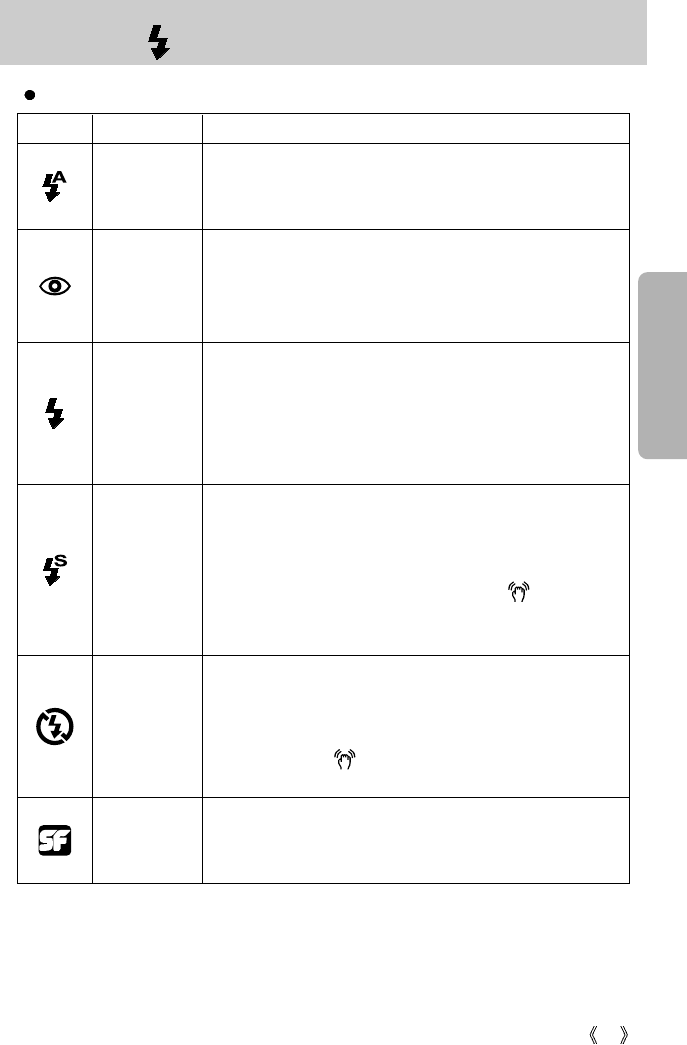
Icon Flash mode Description
33
Flash ( ) / Left button
Flash mode indicator
If the subject or background is dark, the camera flash will operate
automatically.
Auto flash
Auto &
Red eye
reduction
Fill in flash
Slow synchro
SF
(Safety Flash)
Flash off
If a subject or background is dark, the camera flash will work
automatically and will reduce the red-eye effect by using the red-
eye reduction function.
The flash will operate in conjunction with a slow shutter speed in
order to obtain the correct exposure. We recommend using a
tripod for this function. When you take an image in a condition with
poor light, the camera shake warning indicator ( ) will display
on the LCD monitor.
The flash fires regardless of available light.
The intensity of the flash will be controlled, according to the
prevailing conditions. The brighter the background or subject is,
the less intense the flash will be.
The flash does not fire. Select this mode when capturing images in
a place or situation where flash photography is prohibited. When
you capture an image in a poorly lit condition, the camera shake
warning indicator ( ) will display on the LCD monitor.
In poor light conditions, Safety Flash will help you get a good
image without the use of a flash.
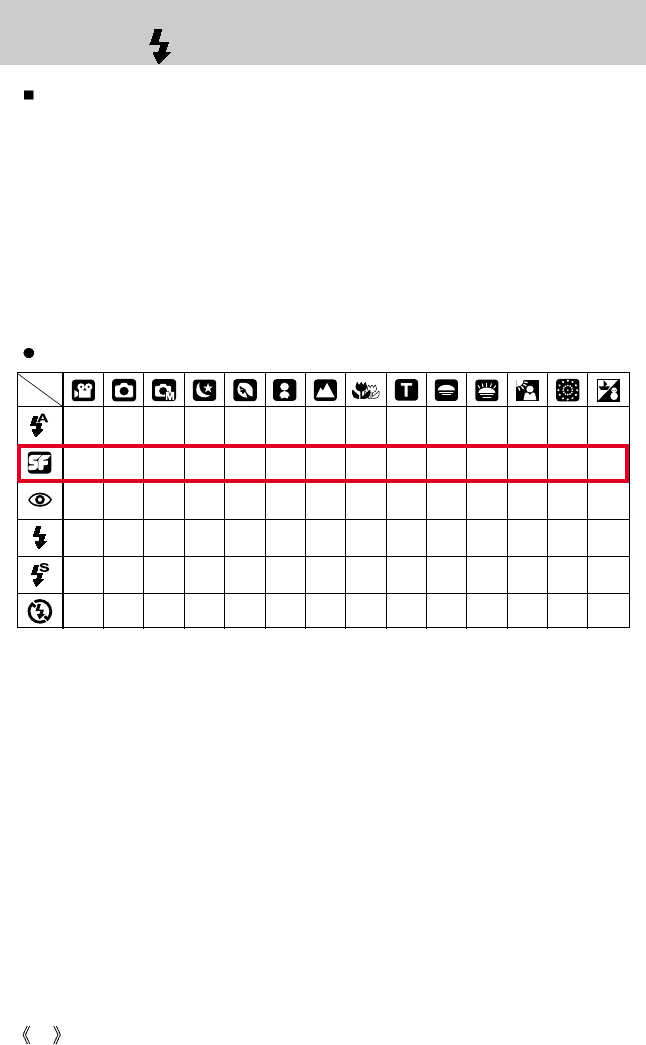
34
Flash ( ) / Left button
Things to watch out for when using the SF(Safety Flash)
1. You can use the SF in the AUTO and MANUAL mode.
2. If you take a moving subject, there may be an afterimage in the captured image.
3. We recommend that you use the SF in a fluorescent lighting condition.
4. If the lighting condition is darker than fluorescent lighting condition, [Low light] message will
display. In this condition, use the correct flash to get a fine image.
5. If the lighting condition is brighter than fluorescent lighting condition, the SF doesn’t
activate.
6. As the SF uses the camera’s digital processor, images taken using the SF may take a little
longer for the camera to process.
Available flash mode, by recording mode
XXOX XX XXXXXX XX
XOOX OO XXXX XX XX
XOOX OO XXXX XX XX
XXOX XX XXXXXOXX
XXOOXX XXXXXXXX
OOO O OO OOOO OX OO
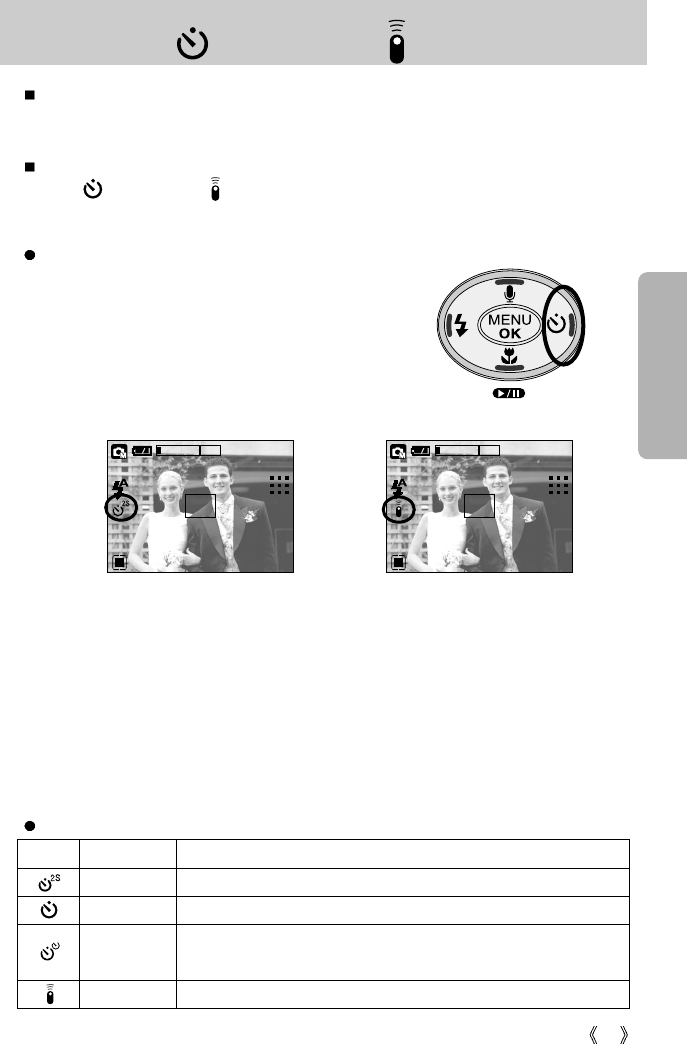
35
Self-timer( ) / Remote ( )/ Right button
When the menu is displayed on the LCD monitor, pressing the Right button makes the cursor
shift to the right tab. The right button can also be used to move to a sub menu to select a
different setting.
When the menu is not displayed on the LCD monitor, the RIGHT button operates as the Self-
timer ( ) and Remote ( ) button. This function is used when the photographer would
also like to be in the image.
Using the self-timer and remote control.
1. Slide the mode switch to the STILL IMAGE or MOVIE
CLIP mode.
In VOICE RECORDING mode, only the remote control
can be used.
2. Press the SELF-TIMER button until the desired mode
indicator displays on the LCD monitor. A self-timer icon
or remote control icon appears on the LCD monitor.
- Selecting a self-timer : When you press the SHUTTER button, the picture will be taken after
the specified time has elapsed and the self-timer function will be
cancelled.
-
Selecting a remote mode
: Pressing the shutter button of remote control will allow an interval of 2
seconds before the image is taken. In the remote mode, the shutter
button of the camera can’t be activated. After taking a picture, the
remote mode will be maintained. But, pressing the power button and
sliding the mode switch will cancel the remote mode.
15
2592
01:00 PM
2005/01/01
15
2592
01:00 PM
2005/01/01
[ Selecting the 2 SEC self-timer ] [ Selecting the remote control ]
Description of Self-timer/Remote mode
Icon Mode Description
2s
Pressing the shutter button will allow an interval of 2 seconds before the image is taken.
10s
Pressing the shutter button will allow an interval of 10 seconds before the image is taken.
A picture will be taken after about 10 seconds and 2 seconds later a
second picture will be taken.
Remote mode
You can take a picture by remote control instead of using the shutter button of the camera.
Double
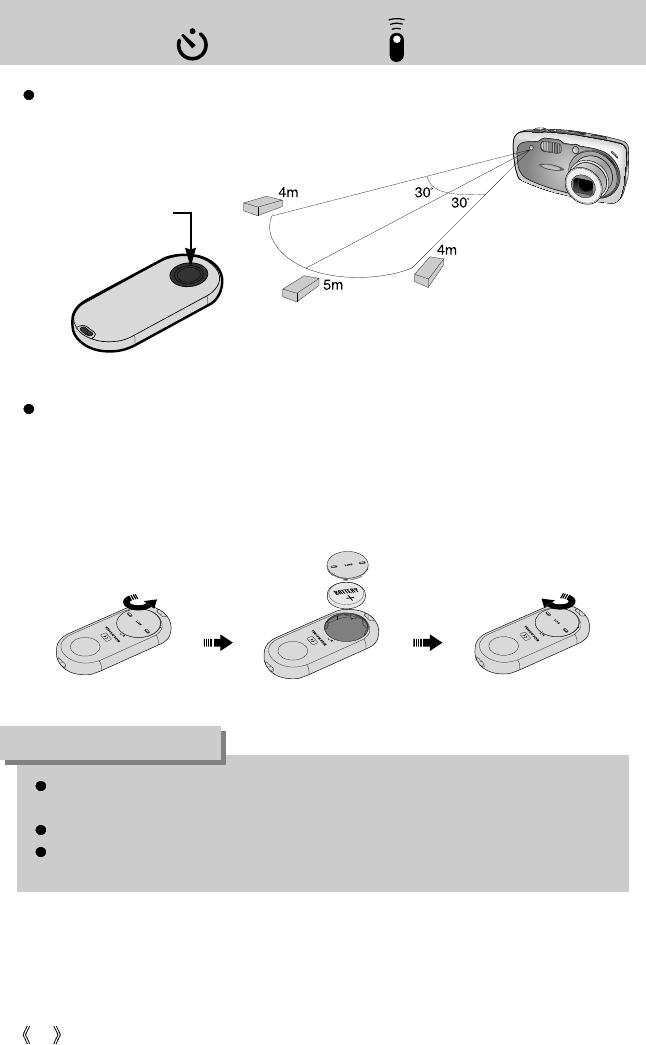
36
Self-timer( ) / Remote ( )/ Right button
[Remote control
shutter button]
Range for taking a picture with the remote control
When you take a picture with the remote control, refer to
the illustration shown alongside.
Replacing batteries for the remote control
Make sure the + polarity is toward the top and the - polarity is toward the bottom while
installing batteries for the remote control.
Replace batteries for the remote control in the local service centre.
Use the CR 2025 3V batteries.
If you operate the Mode switch and Self-timer button during the self-timer operation, the
self-timer function is canceled.
Use a tripod to prevent the camera from shaking.
While the remote control icon is selected, the self-timer lamp in front of the camera blinks
in 1 second cycle.
INFORMATION
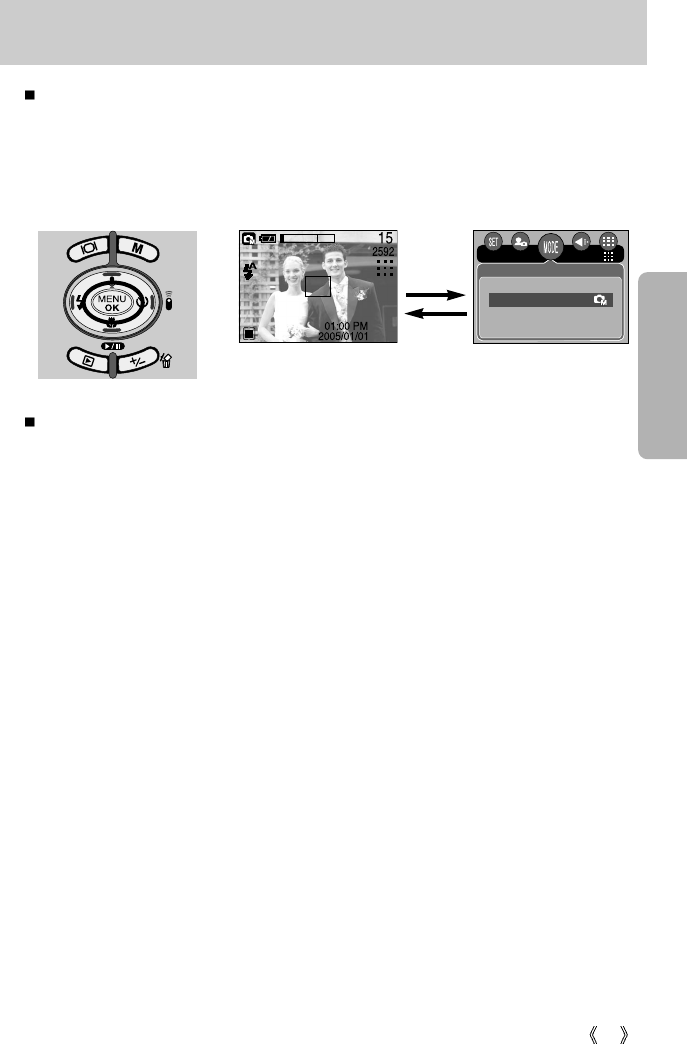
37
MENU/ OK button
[Menu on]
[Menu off]
MENU button
- When you press the MENU button, a menu related to each camera mode will be displayed
on the LCD monitor. Pressing it again will return the LCD to the initial display.
- A menu option can be displayed when the following are selected :
MOVIE CLIP and STILL IMAGE mode. There is no menu available when the VOICE
RECORDING mode is selected.
OK button
- When the menu is displayed on the LCD monitor, this button is used for shifting the cursor
to the sub menu or for confirming data.
Mode
Auto
Manual
Scene
Pressing the
MENU
button
2592
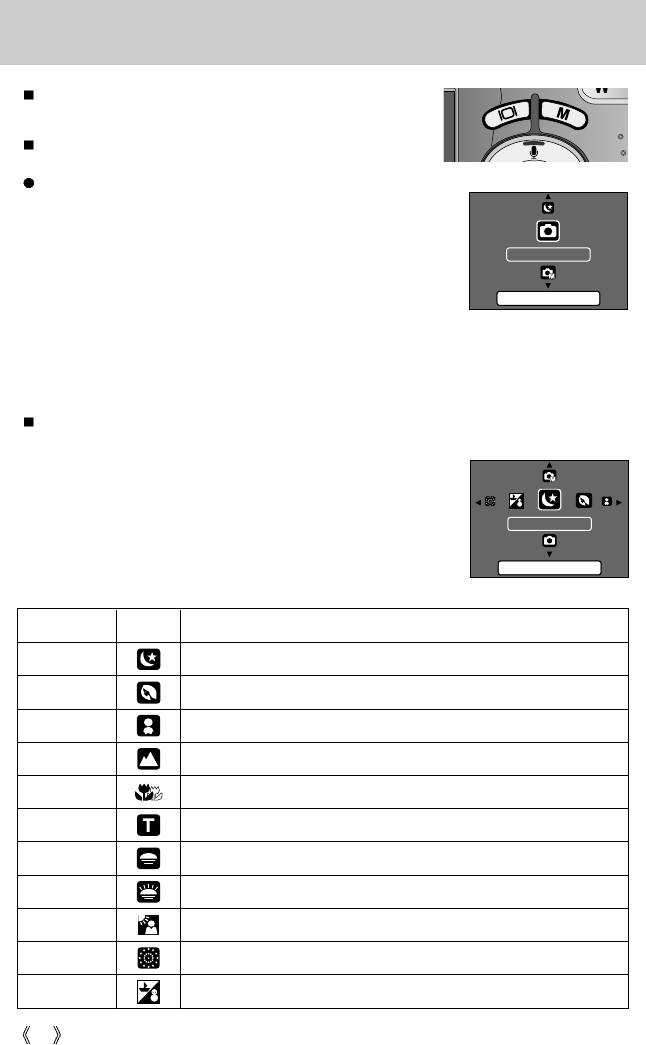
38
M button : selecting preset scene modes
You can use the M button to select the AUTO, MANUAL and
SCENE mode.
This button will operate only in the still image mode
You can easily configure optimal settings for a variety of shooting situations by selecting the
scene sub menus.
How to use the M button
1. Press the M button in the still image mode, and a menu
window will display shown alongside.
2. Select a desired camera mode by pressing the
Up/Down/Left/Right buttons.
- Up/Down button : Selecting a camera mode
- Left/ Right button : Selecting a sub menu of the scene
mode
3. Press the OK button and the desired camera mode will be selected.
1. Press the M button in the still image mode.
2. Select the [Scene] menu by pressing the Up/Down button.
3. Select a desired sub menu by pressing the Left/Right button.
4. Press the OK button and the desired camera mode will be
selected.
Sub menu Icon Description
Night Use this for shooting still images at night or in other dark conditions.
Portrait To take a picture of a person.
Children To take a still picture of moving children.
Landscape Scenery with green woods or blue sky.
Close up Close-up shooting for small objects such as plants and insects.
Text Use this mode to shoot a document.
Sunset For taking pictures of sunsets.
Dawn Daybreak scenes.
Backlight Portrait without shadows caused by backlight.
Firework Firework scenes.
Beach&Snow For ocean, lake, beach and snowscape scenes.
Set:OK/M
Night
SET:OK/M
AUTO
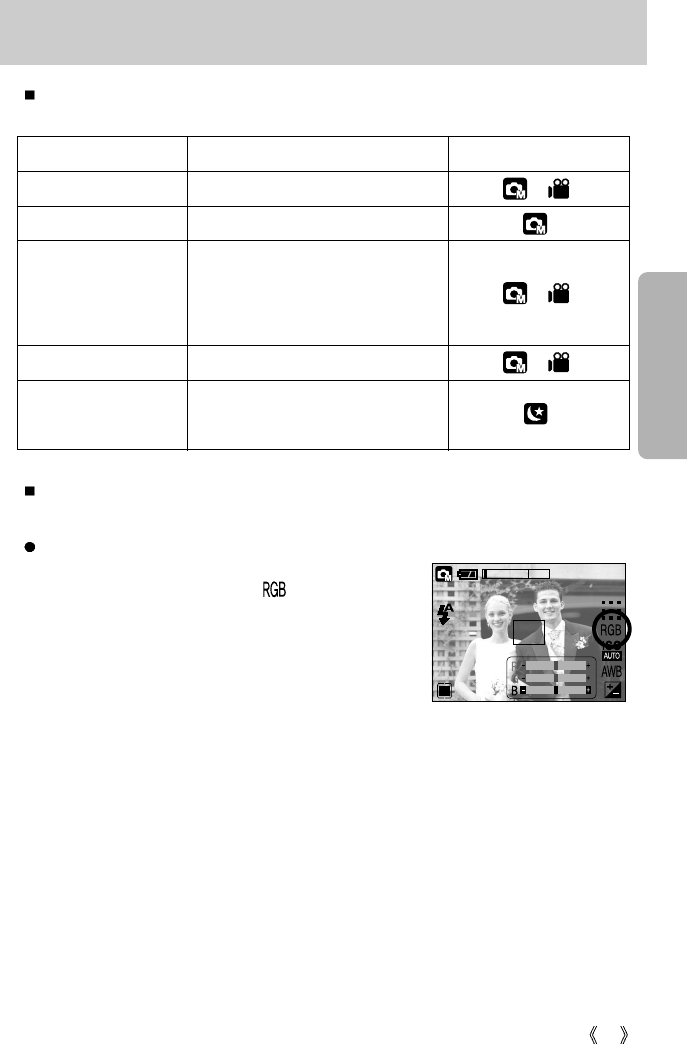
39
+/- button
15
2592
RGB : Allows the user to adjust the R (Red), G (Green), and B (Blue) values of the images to
be captured.
Setting RGB Values
1. Press the +/- button, and then use the UP and DOWN
buttons to select the RGB icon ( ).
The RGB menu bar will appear as shown.
2. Use the UP/ DOWN/ LEFT and RIGHT buttons to select
the desired RGB value.
- Up/Down Button : Navigates between R, G, and B
icons.
- Left/Right Button : Changes value of each icon.
3. When you press the +/- button again, the value you set will be saved and RGB setup
mode will end.
You can use the +/- button to adjust the values for the RGB, ISO, white balance, exposure
compensation and Long Time shutter speed.
Main menu Sub menu Available camera mode
RGB R (Red), G (Green), B (Blue)
ISO AUTO, 100, 200, 400
WHITE BALANCE
Exposure compensation -2.0 ~ 0.0 ~ +2.0 (0.5EV steps)
LT Shutter speed / Aperture Value
(Changed by zoom rate)
AUTO, DAYLIGHT, CLOUDY,
FLUORESCENT H, FLUORESCENT L,
TUNGSTEN, CUSTOM.
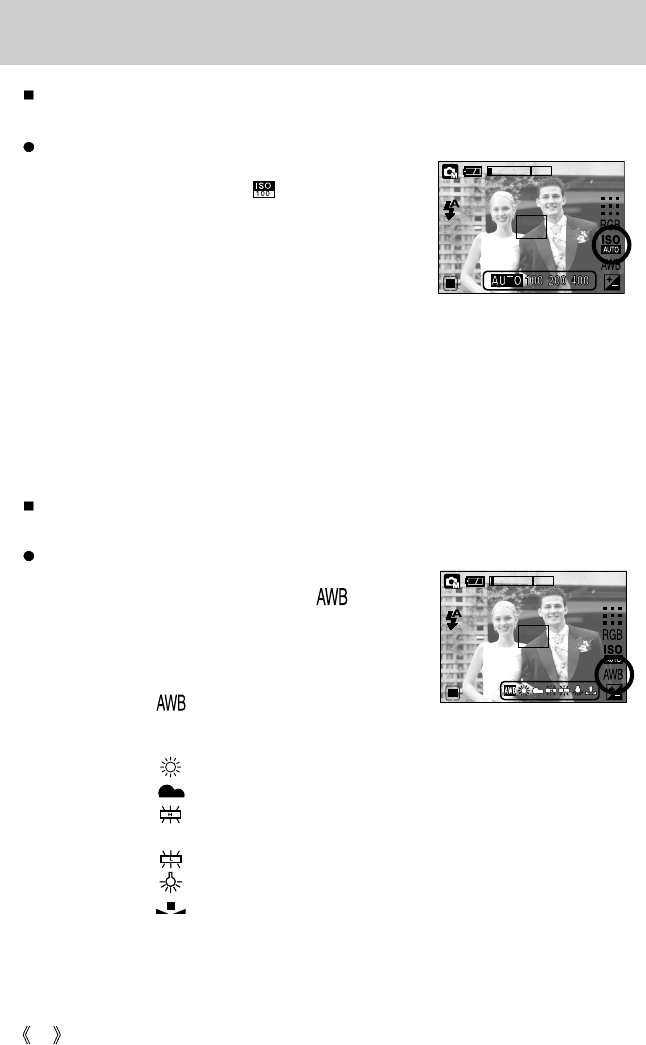
40
+/- button
Selecting an ISO Sensitivity
1. Press the +/- button, and then use the UP and DOWN
buttons to select the ISO icon( ). The ISO menu bar
will appear as shown.
2. Use the LEFT and RIGHT buttons to select the desired
ISO sensitivity value.
- AUTO : The camera's sensitivity is automatically
changed by variables such as lighting
value or subject brightness.
- 100, 200, 400: You can increase the shutter speed while the same amount of light is
present, by increasing the ISO sensitivity. However, the image may be
saturated in high luminance. The higher the ISO value, the higher the
camera’s sensitivity to light is and therefore the greater its capacity to take
pictures in dark conditions. However, the noise level in the image will
increase as the ISO value increases, making the image appear coarse.
3.
When you press the +/- button again, the value you set will be saved and ISO setup mode will end.
15
2592
Selecting a White Balance
1. Press the +/- button, and then use the UP and DOWN
buttons to select the white balance icon ( ).
The white balance menu bar will appear as shown.
2. Use the LEFT and RIGHT buttons to set the white
balance to the desired value. The value you set will be
displayed on the LCD monitor.
AUTO : The camera automatically selects
the appropriate white balance
settings, depending on the prevailing lighting conditions.
DAYLIGHT : For taking images outside.
CLOUDY : For taking images under a cloudy and overcast sky.
Fluorescent H : For shooting under daylight fluorescent types of three-way
fluorescent lighting.
Fluorescent L : Shooting under white fluorescent lighting.
TUNGSTEN : For shooting under tungsten (standard light bulb) lighting.
CUSTOM : Allows the user to set the white balance according to the shooting
condition.
Different lighting conditions may cause a colour cast on your images.
3. Press the +/- button again. The value you set will be saved and White Balance setup mode
will end.
15
2592
ISO : You can select the ISO sensitivity when taking pictures.
The speed or specific light-sensitivity of a camera is rated by ISO numbers.
White balance : The white balance control allows you to adjust the colours to appear more
natural looking.
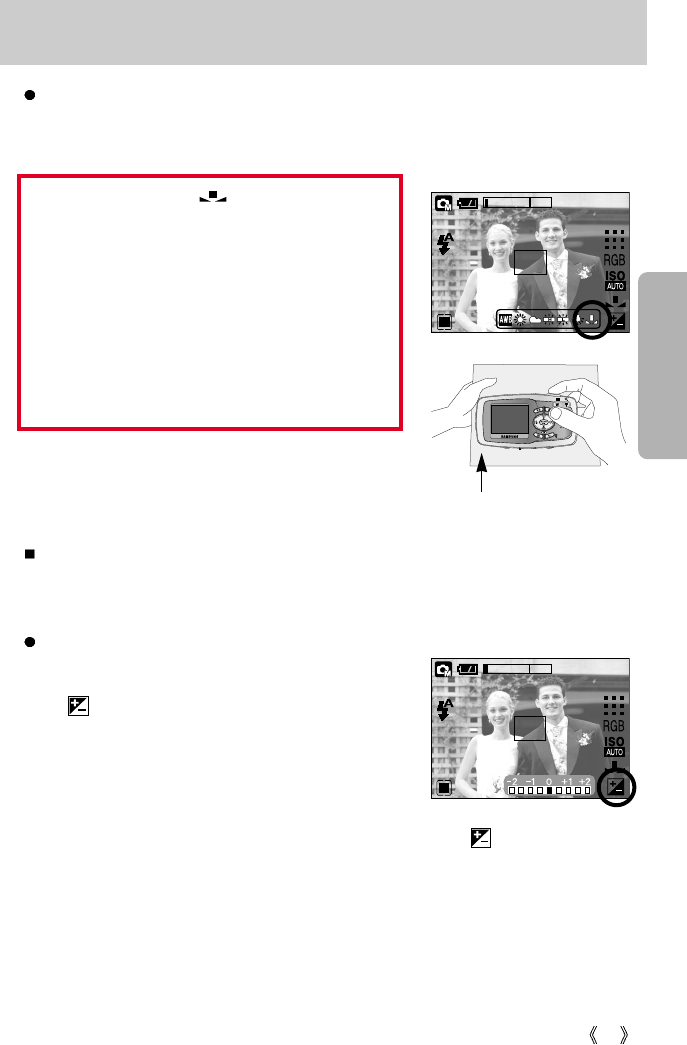
41
+/- button
15
2592
Using the Custom White Balance
White balance settings may vary slightly depending on the shooting environment.
You can select the most appropriate white balance setting for a given shooting environment
by setting up the custom white balance.
1. Select the CUSTOM ( ) menu of the White
Balance.
2. Place a sheet of white paper in front of the camera so
that the LCD monitor shows only white, and then press
the SHUTTER button.
3. Your custom white balance value is stored.
- The custom white balance value will be applied,
starting with the next picture you take.
- The user configured white balance will be remain
effective until it is overwritten.
[ White paper ]
MEASURE : SHUTTER
15
2592
Exposure compensation : This camera automatically adjusts the exposure according to the
ambient lighting conditions.
You can also select the exposure value by using the +/- button.
Compensating Exposure
1. Press the +/- button, and then use the UP and DOWN
buttons to select the exposure compensation icon
( ). The exposure compensation menu bar will
appear as shown.
2. Use the LEFT and RIGHT buttons to set the desired
exposure compensation factor.
3. Press the +/- button again. The value you set will be
saved and the Exposure Compensation setup mode will
close. If you change the exposure value, the exposure indicator ( ) will be displayed
on the bottom of the LCD monitor.
* A negative exposure compensation value reduces the exposure.
Note that a positive exposure compensation value increases the exposure and the LCD
monitor will appear white or you may not get good pictures.
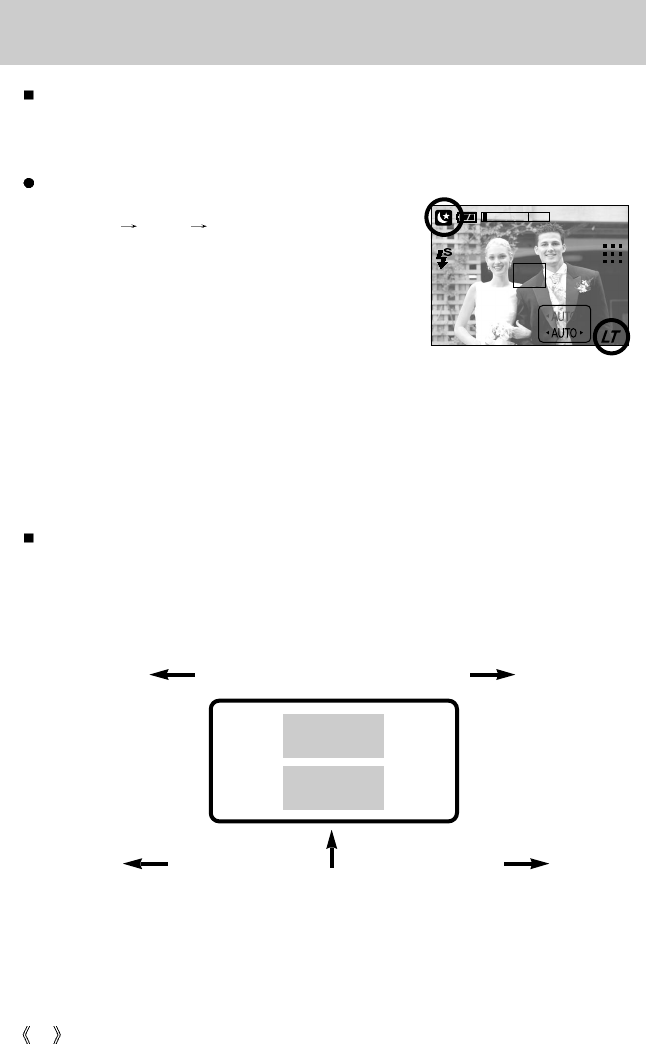
42
+/- button
15
2592
Long Time shutter : This camera automatically adjusts the shutter speed and aperture values
to the shooting environment. However, in NIGHT SCENE mode, you can
set the shutter speed and aperture values to your preference.
Adjusting the shutter speed and aperture values
1. Select the [Night] scene mode.
(M button [Scene] [Night])
2. Press +/- button and Long Time shutter menu
(LT, For selecting shutter speed and aperture value) will
be displayed.
3. Configure the Long Time shutter value with the up/
down/ left/ right button.
Up/ Down Button : Select the iris / shutter speed
Left/ Right Button : Change the value. Available iris value options, depending on zoom step
will be displayed on the menu.
4. Press the +/- button again. The value you set will be saved and the mode will switch to
NIGHT SCENE mode. Press the SHUTTER button to take the picture.
(Press left button)
Aperture Value SmallLarge
(Press right button)
Shutter Speed
Fast
(Press left button)
Slow
(Press right button)
Aperture values and shutter speeds changed by zoom scale are listed below.
F 2.8
1 S
Supported Aperture Values : AUTO, WIDE : F2.8 ~ F5.8, TELE : F4.8 ~ F10.0
Supported Shutter Speeds : AUTO, 1 ~ 16S
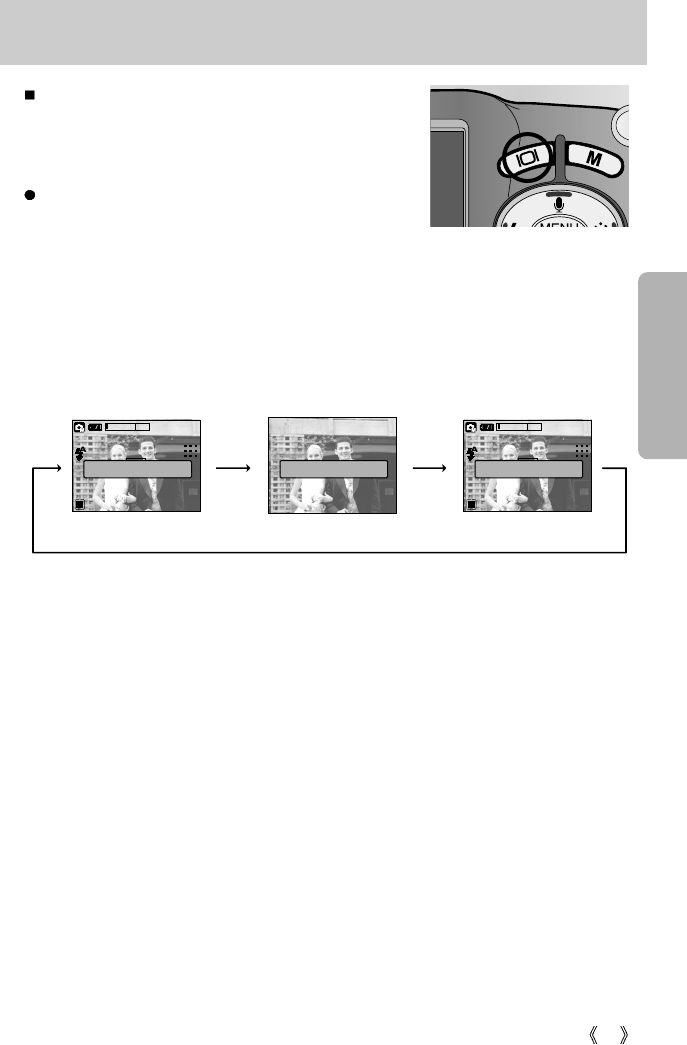
43
LCD button
15 15
2592
01:00 PM
2005/01/01
15
2592
01:00 PM
2005/01/01
[Full Information Mode] [Basic Information Mode] [Power save mode]
You can check the recording status in the LCD monitor.
In any mode with the exception of VOICE RECORDING
mode, pressing the LCD button will change the display as
shown below.
Idle mode
- After selecting Save mode by pressing the LCD button,
and if the camera isn't operated during the specified
time(about 30 SEC.), the camera power will be idle
(LCD monitor : OFF, Button lamp : Blinking) automatically.
- To use the camera again, press any of the camera buttons except the power button.
- If there is no operation during the specified time, the camera power will be turned off
automatically to save battery life. Refer to page 70 for more information about the auto
power off function.
Pressing the
LCD button
Pressing the
LCD button
Pressing the LCD button
Full Inf. Mode Basic Inf. Mode Save Mode
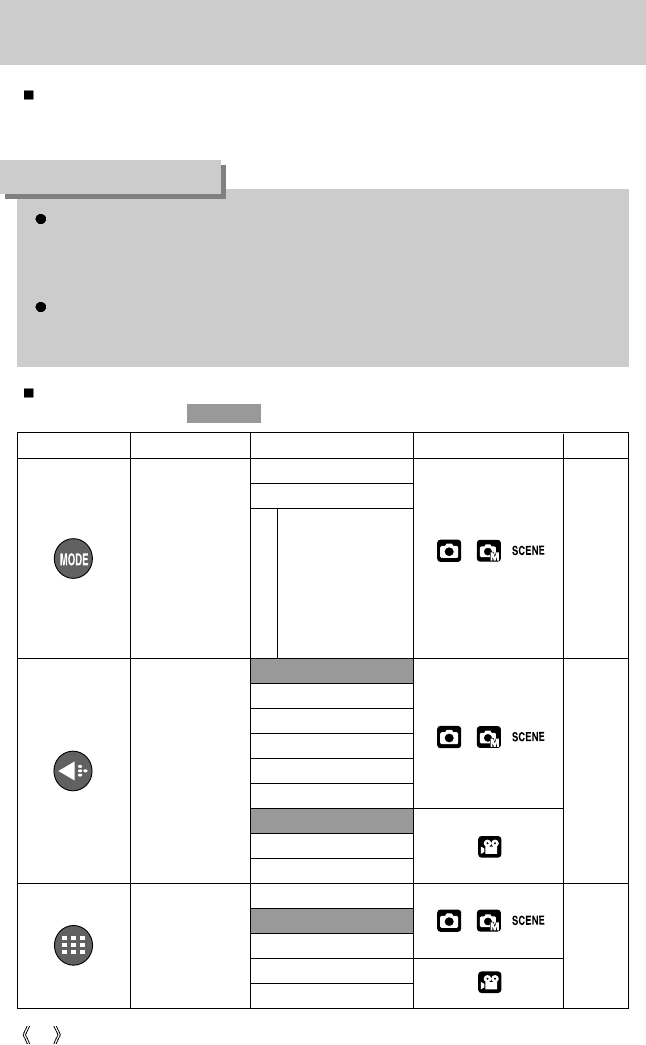
44
Using the LCD monitor to adjust the camera settings
You can use the menu on the LCD monitor to set up recording functions. In any mode with
the exception of VOICE RECORDING mode, pressing the MENU button displays the menu
on the LCD monitor.
The menu will not be displayed on the LCD monitor in the following circumstances:
- When another button is being operated.
- While image data is being processed.
- When there is no battery capacity.
When the menu is showing on the LCD monitor, it is not possible to operate the shutter
button i.e. capture an image. To capture an image, simply cancel the menu display by
pressing the MENU button.
INFORMATION
The following functions are available, depending on the mode you have selected.
The items indicated by are default settings.
Menu tab Main menu Sub menu Camera working mode Page
Auto
Manual
2592X1944
2272X1704
2048X1536
1600X1200
1024X768
640X480
640X480
320X240
160X128
S. Fine
Fine
Normal
30FPS
15FPS
Mode
Night, Portrait,
Children, Landscape,
Close up, Text,
Sunset, Dawn,
Backlight, Firework,
Beach&Snow
Size
Quality
S
c
e
n
e
p.36
p.37
p.38
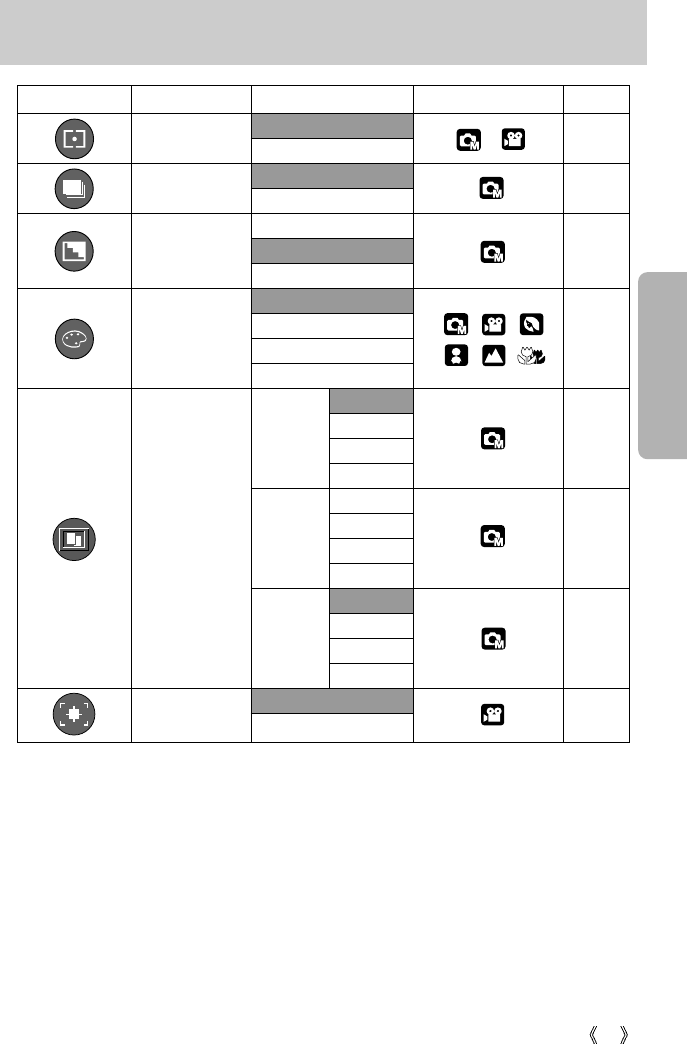
45
Using the LCD monitor to adjust the camera settings
Menu tab Main menu Sub menu
Camera working mode
Page
Multi
Spot
Single
Continuous
Soft
Normal
Vivid
Normal
B&W
Sepia
Negative
Off
Range 1
Range 2
Range 3
Off
2 Parts
3 Parts
4 Parts
Off
Frame 1
Frame 2
Frame 3
Off
On
Shooting
Effect
Special Effect
Photo Frame
HighLight
Composite
Sharpness
Stabilizer
p.39
p.41
p.53
p.53
p.42
p.43
p.43
p.40
* Menus are subject to change without prior notice.
Metering
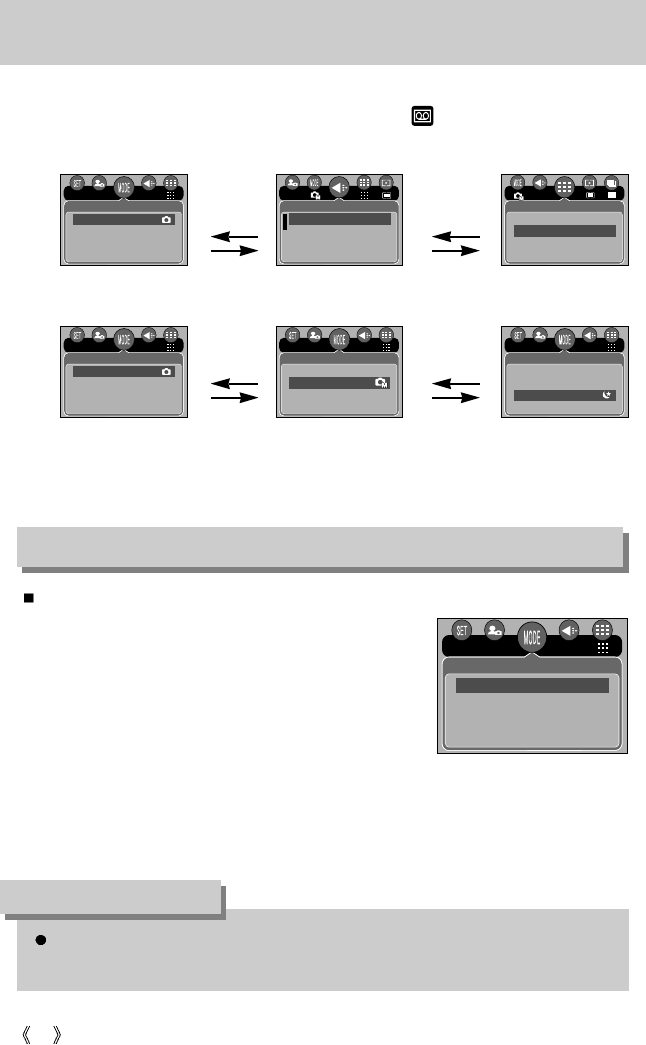
46
How to use the menu
3. Use the UP and DOWN buttons to select a sub menu.
4. Select a sub menu, and then the value you set will be saved. Press the MENU button and
the menu will disappear.
1. Turn on the camera and press the MENU button. A menu for each camera mode appears.
However, there is no menu for Voice Recording mode ( ).
2. Use the LEFT and RIGHT buttons to navigate through the menus.
Mode
Press the UP or
DOWN button.
Press the UP or
DOWN button.
[STILL IMAGE mode]
Press the LEFT
or RIGHT button.
Press the LEFT or
RIGHT button.
You can select the desired Still Image mode.
[Auto] : Use this for shooting basic still images.
[Manual] : Selecting the automatic mode will configure
the camera with optimal settings.
You can still manually configure all functions
except the aperture value and shutter speed.
[Scene] : Use the menu to easily configure optimal
settings for a variety of shooting situations
- The selected [Scene] sub menu will be
displayed on the LCD monitor.
To change the sub menu or to get more information about the scene menus,
refer to page 70.
When [Night], [Close up], [Sunset], [Dawn] and [Firework] scene mode are selected, it is
possible that camera shake will occur. If you think this will happen, use a tripod.
INFORMATION
Mode
Auto
Manual
Scene
2592
Mode
Auto
Manual
Scene
2592
Mode
Auto
Manual
Scene
2592
Mode
Auto
Manual
Scene
2592
Size
2592X1944
2272X1704
2048X1536
1600X1200
2592
Quality
S.Fine
Fine
Normal
2592
Mode
Auto
Manual
Scene
2592
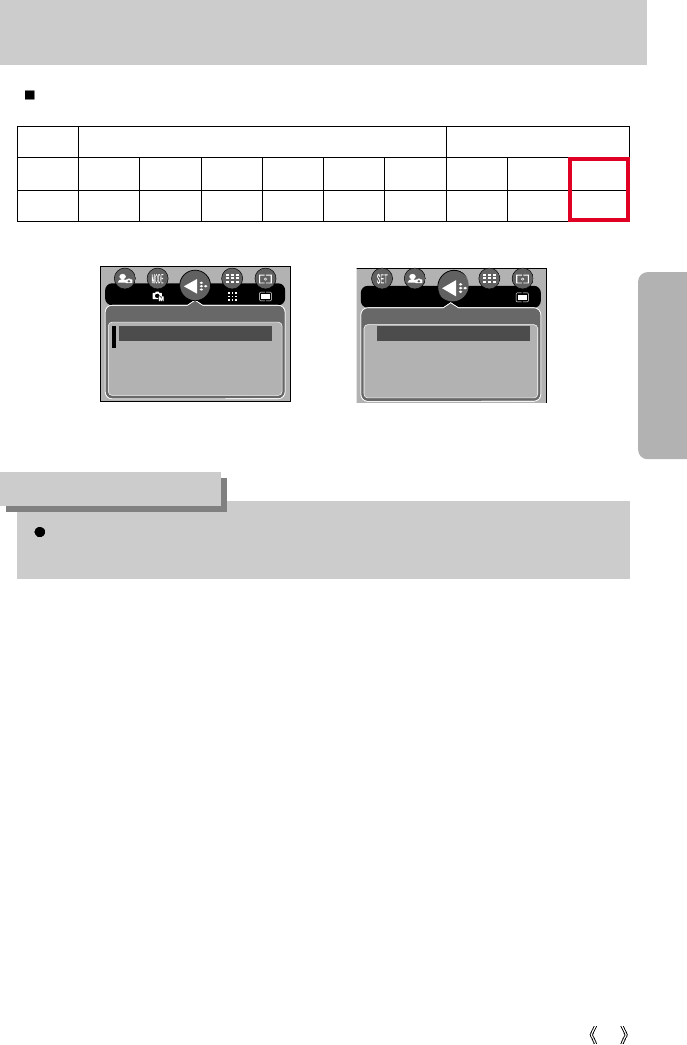
47
Size
You can select the image size appropriate for your application.
Icon
2592 2272 2048 1600 1024 640 640 320 160
Size
2592
X
1944
2272X1704 2048X1536 1600
X
1200
1024
X
768 640X480 640X480 320X240 160X128
The higher the resolution, the lower the number of available shots will be because high
resolution images require more memory than lower resolution images.
INFORMATION
STILL IMAGE modeMode MOVIE CLIP mode
[ STILL IMAGE mode ] [ MOVIE CLIP mode ]
Size
2592X1944
2272X1704
2048X1536
1600X1200
2592
Size
640X480
320X240
160X128
640
30FPS
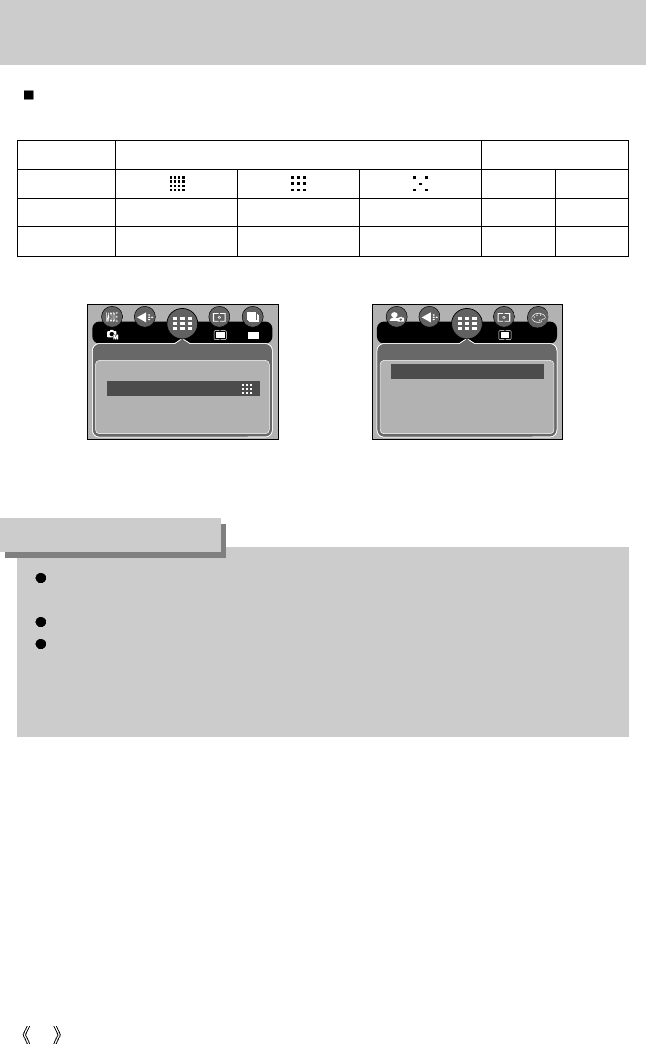
48
Quality
You can select the compression ratio appropriate for your application of the captured images.
The higher the compression ratio, the lower the picture quality.
Mode
Icon 30FPS 15FPS
Sub menu S. Fine Fine Normal
30
FPS 15FPS
File Format jpeg jpeg jpeg avi avi
STILL IMAGE mode MOVIE CLIP mode
S. Fine is the highest quality and Normal is the lowest setting.
Choose the setting appropriate for your needs.
This file format complies with the DCF(Design rule for Camera File system).
JPEG (Joint Photographic Experts Group) : JPEG is the image compression standard
developed by the Joint Photographic Experts Group. This type of compression is most
commonly used for compressing photos and graphics because it can compress the files
efficiently without damaging the data.
INFORMATION
[ STILL IMAGE mode ] [ MOVIE CLIP mode ]
Quality
S.Fine
Fine
Normal
2592
Frame Rate
30 FPS
15 FPS
640
NOR
30 FPS
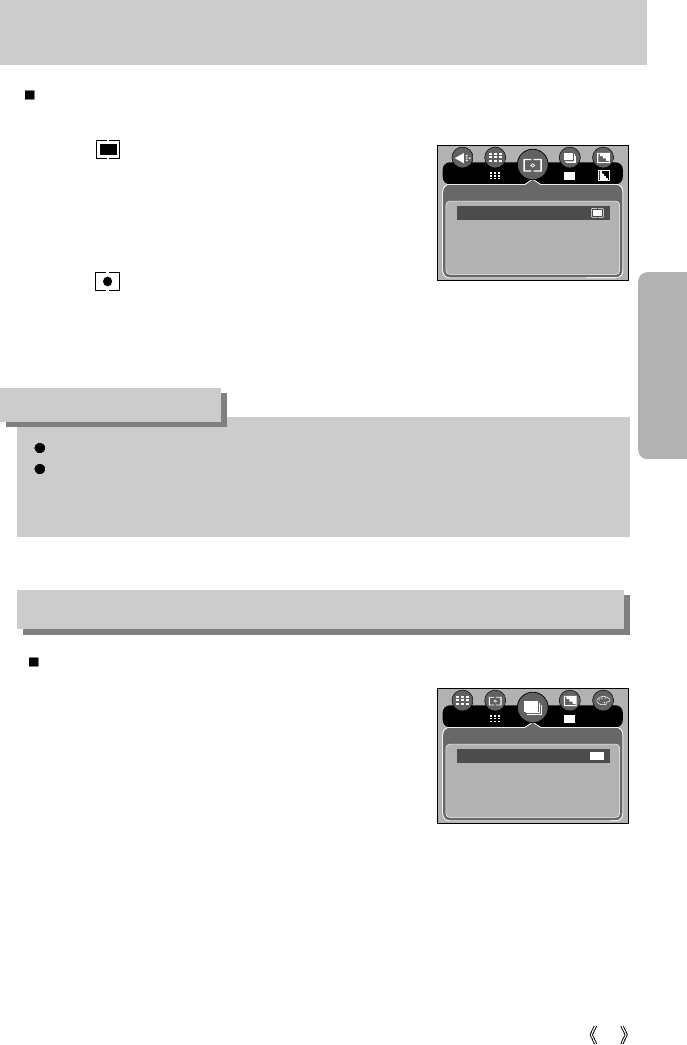
49
Metering
If you cannot obtain suitable exposure conditions, you can change the metering method to
take brighter pictures.
[Multi] ( ) : Exposure will be calculated based on
an average of the available light in the
image area. However, the calculation
will be biased towards the centre of
the image area. This is suitable for
general use.
[Spot] ( ) : Only the rectangular area in the
centre of the LCD monitor will be
metered for light. This is suitable when the subject in the centre is
exposed correctly, regardless of the back lighting.
The default metering mode is Multi pattern metering.
If the subject is not the centre of the focus area, do not use the spot metering as this may
result in an exposure error. In this circumstance, It is better to use exposure
compensation.
INFORMATION
Continuous shot
Select the number of pictures in continuous shooting.
- [Single] : Take one picture only
- [Continuous] : Images will be taken continuously
until the shutter button is released.
The shooting capacity depends on
the memory.
[MANUAL mode]
1
* High resolution and picture quality increases file saving
time, which increases stand-by time.
* If the [Continuous] sub menu is selected, the flash will be off automatically.
Metering
Multi
Spot
2592
Shooting
Single
Continous
2592 NOR
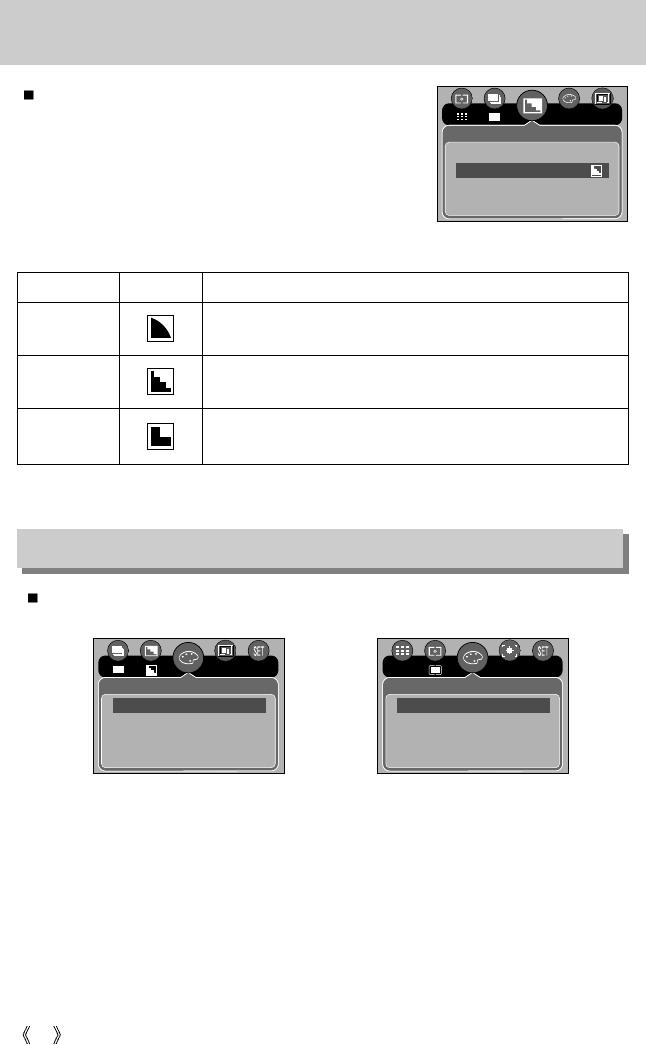
50
Sharpness
By using the camera’s digital processor, it is possible to add special effects to your images.
[MANUAL mode ] [ MOVIE CLIP mode ]
[Normal] : No effect is added to the image.
[B & W] : Converts the image to black and white.
[Sepia] : Captured images will be stored in a sepia tone
(a gradient of yellowish brown colours).
[Negative] : Save the image in negative mode.
Effect
You can adjust the sharpness of the picture you want to
take. You cannot check the sharpness effect on the LCD
monitor before you take a picture, because this function is
applied only when the captured image is stored on the
memory.
[MANUAL mode]
Sub menu Icon Description
The edges of the image are softened.
This effect is suitable for editing images on your PC.
The edges of the image are sharp.
This is suitable for printing.
The edges of the image are emphasized. The edges will appear
sharp, but noise may occur in the recorded image.
Vivid
Normal
Soft
Sharpness
Soft
Normal
Vivid
NOR
Effect
Normal
B & W
Sepia
Negative
NOR
Effect
Normal
B & W
Sepia
Negative
NOR
30FPS
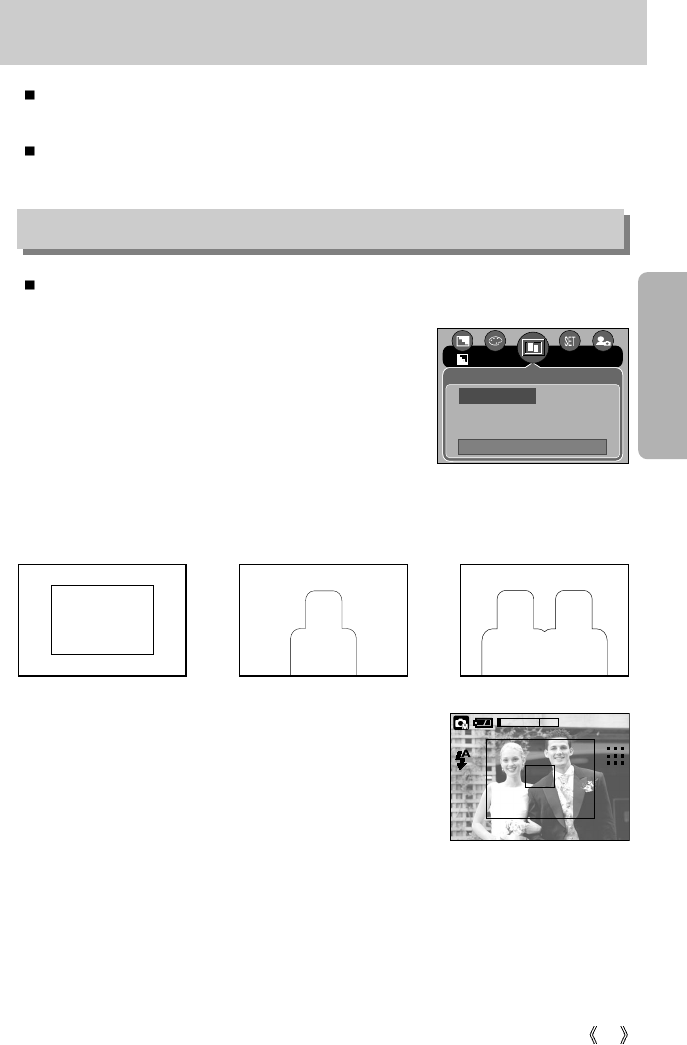
51
Special Effect
By using the camera’s digital processor, it is possible to add special effects to your images.
You can select this menu only in the MANUAL mode.
You can select the preset focus frame, Composite shots and Photo frame function. If a
special effect is selected, the rest special functions set before are cancelled automatically.
You can make the subject stand out from its surroundings.
The subject will be sharp and in focus while making the rest out of focus.
1. Select the MANUAL mode, and press the menu button.
2. Press the LEFT/ RIGHT button and select the
[Special Effect] menu tab.
3. Select the [HighLight] menu by pressing the UP/ DOWN
button and press the Right button.
4. Select a desired sub menu by pressing the UP/ DOWN
button and press the OK button.
- [Off] : The preset focus frame will not be added.
Special Effect : Preset focus frames
[ Range 1] [ Range 2] [ Range 3]
5. Press the menu button twice and the menu will disappear.
If you select the [Range 1~3] menu, the preset focus
frame area will appear.
Special Effect
Highlight
Composite
Photo Frame
Off
Off
Off
NOR
Move : Set : OK
15
2592
01:00 PM
2005/01/01
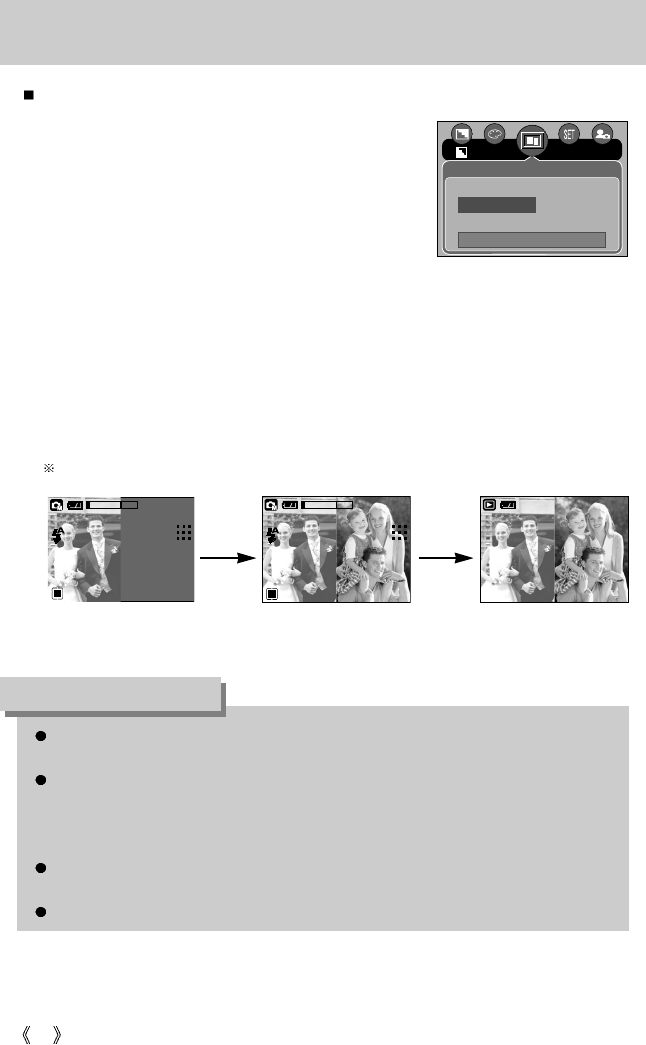
52
[ 1/2 ] [ 2/2 ] [ The result image ]
Special Effect : Composite shots
You can combine 2 ~ 4 different shots in a still image.
1. Select the Still image mode, and press the menu button.
2. Press the LEFT/ RIGHT button and select the
[Special Effect] menu tab.
3. Select the [Composite] menu by pressing the UP/ DOWN
button and press the Right button.
4. Select a desired sub menu by pressing the UP/ DOWN
button and press the OK button.
- [Off] : cancels the composite shots
- [2 Parts] : 2 different shots are combined in a still image.
- [3 Parts] : 3 different shots are combined in a still image.
- [4 Parts] : 4 different shots are combined in a still image.
5. Press the menu button twice and the menu will disappear.
6. The number of frames you selected in step 4 is displayed on the LCD monitor.
Press the shutter button to start the composite shots
15
2592
01:00 PM
2005/01/01
15
2592
01:00 PM
2005/01/01
Pressing
the shutter
button
Pressing
the shutter
button
Special Effect
Highlight
Composite
Photo Frame
Off
Off
Off
NOR
Move : Set : OK
You can use the flash button, self-timer button, macro button, +/- button and the Zoom
W/T button during the composite shots.
If you press the camera buttons (Menu button, Play mode button and M button) or rotate
the mode switch during the composite shots, the captured images aren’t saved and the
first step of the composite shot will display on the LCD monitor. Do not press the camera
buttons or rotate the mode switch during the composite shots.
To insert the voice memo, press the voice memo button before starting the composite
shot. The voice memo will start after taking the last composite shot.
If you select [Cancel] in the [Composite] menu, the composite shot will be cancelled.
INFORMATION
Selecting 2 composite shots
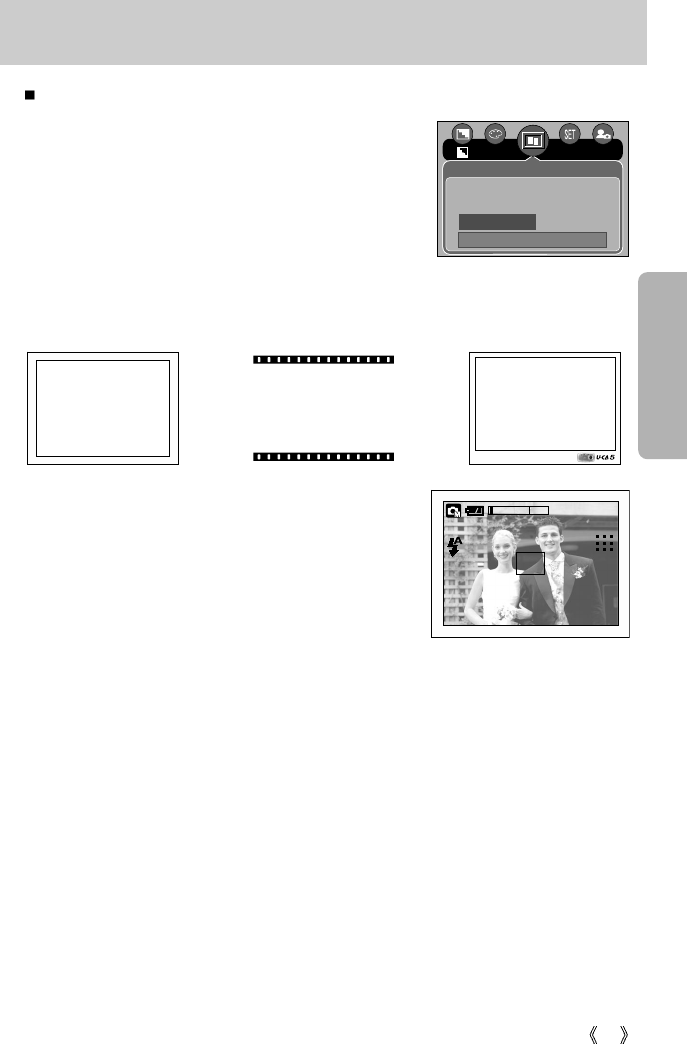
53
Special Effect : Photo Frame
You can add 3 types of frame-like borders to a still image you want to capture.
1. Select the Still image mode, and press the menu button.
2. Press the LEFT/ RIGHT button and select the
[Special Effect] menu tab.
3. Select the [Photo Frame] menu by pressing the UP/
DOWN button and press the Right button.
4. Select a desired sub menu by pressing the UP/ DOWN
button and press the OK button.
- [Off] : The photo frame will not be added.
5. Press the menu button twice and the menu will
disappear. If you select the [Frame 1~3] menu, the
preset focus frame area will appear.
* You can check the photo frame you added to pictures in
Quick View or Play mode.
[Frame1] [Frame2] [Frame3]
Special Effect
Highlight
Part Shot
Photo Frame
OFF
OFF
OFF
NOR
Move : Set : OK
15
2592
01:00 PM
2005/01/01
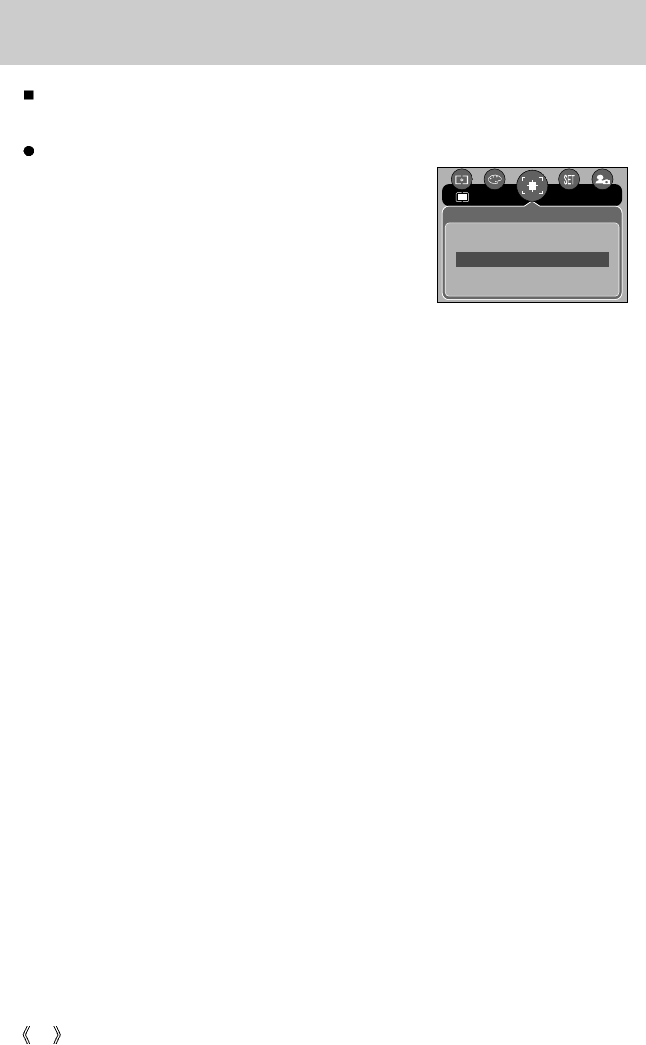
54
Movie Clip frame stabiliser
This function helps stabilize images captured during movie recording.
You can select this menu only in the MOVIE CLIP mode.
How to use this function
1. Select the MOVIE CLIP mode by sliding the mode
switch and press the menu button. Select the [Stabilizer]
menu and press the right button.
2. Select a desired sub menu by pressing the Up/Down
button and press the OK button.
- [Off] : Movie clip frame stabilizer function becomes
disable.
- [On] : Prevents camera shake during movie
recording. The recording frame range will become narrower than when you select
the [Off] menu. Pre-view frames may not display smoothly on the LCD monitor,
but stored movie clips have no problems.
Stabilizer
Off
On
NOR
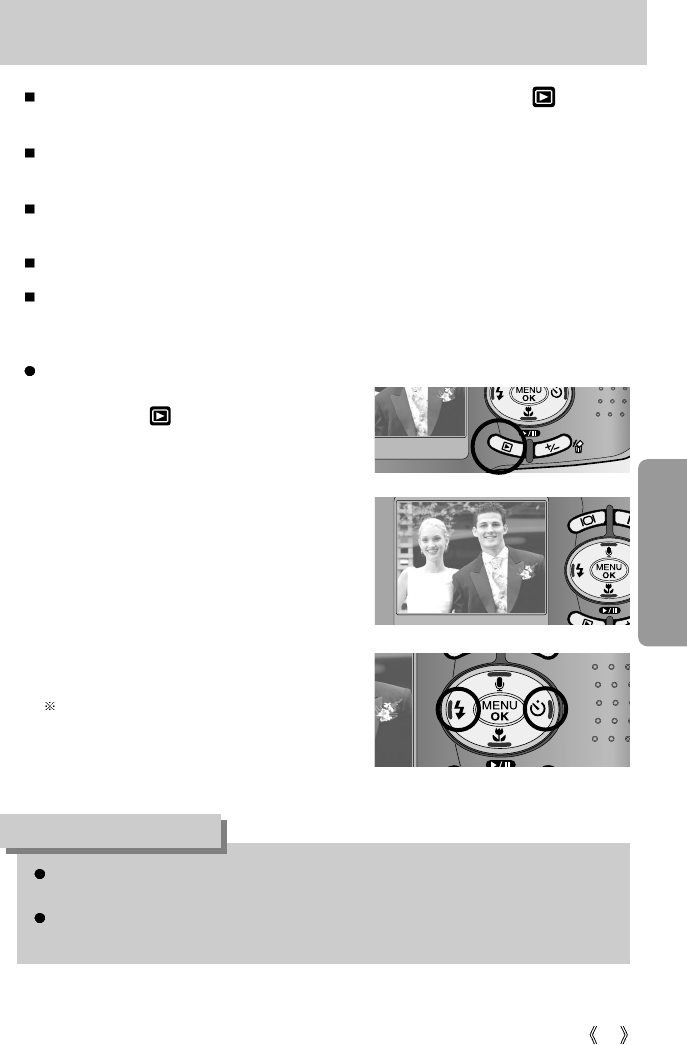
55
Starting play mode
Turn the camera on and select Play mode by pressing the play mode button ( ).
The camera can now play back the images stored in the memory.
If you have turned on the camera by pressing the POWER button, you can press the PLAY
MODE button once to switch to Play mode and press it again to switch to Recording mode.
You can turn the power on with the play mode button. The camera is turned on in play mode.
Press the play mode button again to turn off the camera.
You can set up the PLAY mode function by using the camera buttons and LCD monitor.
If you press the PLAY button to switch to Play mode, the camera lens will retract into the
camera body for protection of the lens after about 10 seconds.
Playing back a still image
1. Select the PLAY mode by pressing the play
mode button ( ).
2. The last image stored on the memory is
displayed on the LCD monitor.
3. Select an image that you want to view by
pressing the LEFT / RIGHT button.
Press and hold the LEFT or RIGHT button to
play back the images quickly.
Manner mode : Pressing the power button for more than 3 seconds changes the buzzer
and start-up sound setting to OFF, even though you may have set these to ON.
Even if the camera’s power is off, you can start the play mode by pressing the play mode
button.
INFORMATION
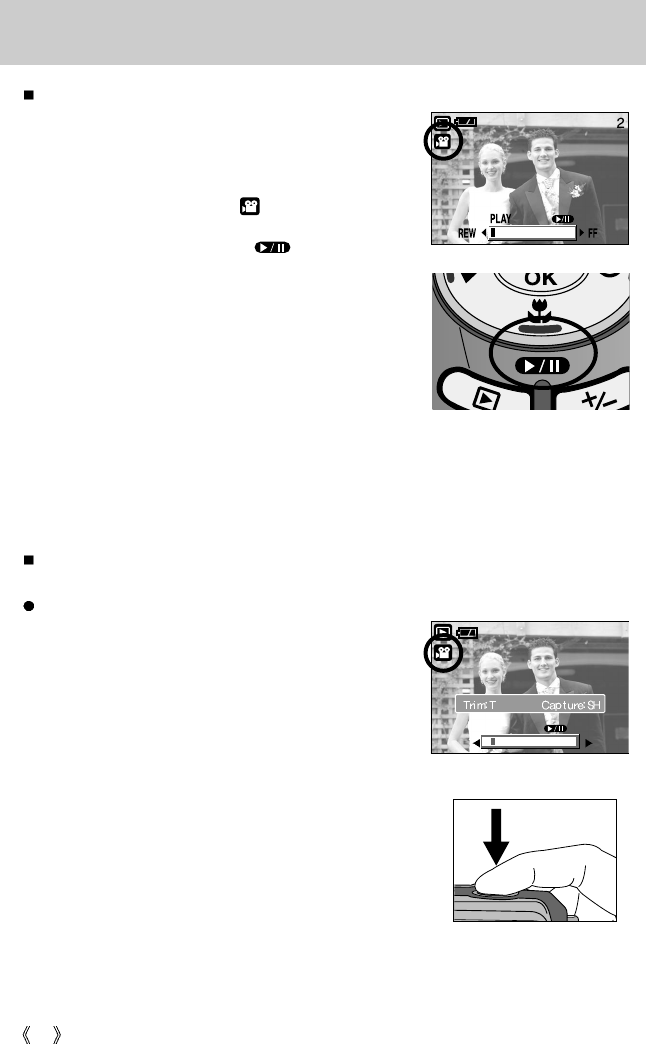
56
Starting play mode
Playing back a movie clip
Steps from 1-2 are the same as those to play back a still
image.
3. Select the recorded movie clip that you want to play back
by using the LEFT/RIGHT button. If you select a movie
clip, the movie clip indicator ( ) will be displayed on the
LCD monitor.
4. Press the play & pause button ( ) to play back a
movie clip file.
- To pause a movie clip file while playing it back, press the
play & pause button again.
- Pressing the play & pause button again will cause the
movie clip file will restart.
- To rewind the movie clip while it is playing, press the
LEFT button. To fast forward the movie clip, press the
RIGHT button.
- To stop playback of the movie clip, press the play & pause button, and then press the
LEFT or RIGHT button.
How to capture the movie clip
Steps 1-2 are the same as those for playing back a still
image.
3. Select the recorded movie clip that you want to play
back by using the LEFT/RIGHT button.
4. Press the Play/Pause button to play the movie clip
5. Press the Play/Pause button while playing the movie
clip. Then press the Shutter button.
6. The paused movie clip is saved in a new file name.
* The captured movie clip file has same size as the original
movie clip (640X480, 320X240, 160X128).
Movie clip capture function: capture still images from the movie clip.
[ Paused ]
[ Press the shutter button ]
15
PLAY
REW FF
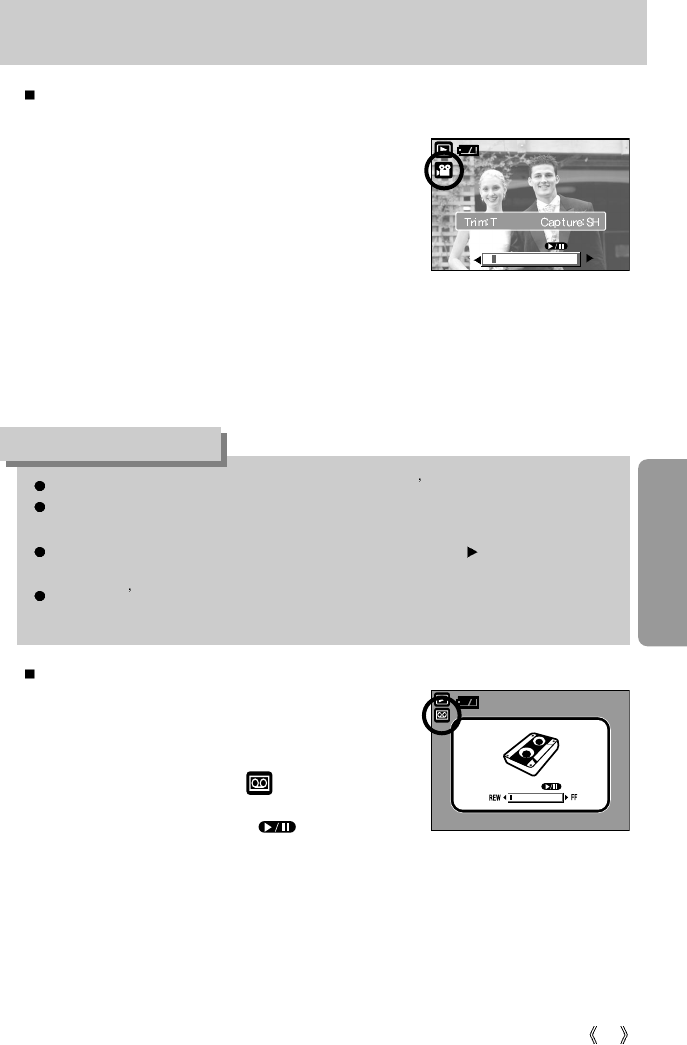
57
Starting play mode
Playing back a recorded voice
Steps from 1-2 are the same as those to play back a still
image.
3. Select the recorded voice that you want to play back by
using the LEFT/RIGHT button. If you select a recorded
voice file, the voice indicator ( ) will be displayed on
the LCD monitor.
4. Press the play & pause button ( ) to play back a
recorded voice file.
- To pause a recorded voice file, while playing it back, press the play & pause button again.
- To resume playback of the voice file, press the play & pause button.
- To rewind the voice file while it is playing, press the LEFT button.
To fast forward the voice file, press the RIGHT button.
- To stop playback of the voice file, press the play & pause button, and then press the
LEFT or RIGHT button.
3
On camera movie trimming : You can extract desired frames of movie clip during the movie
clip play back.
1. Select a desired movie clip in the play mode.
2. Play back the movie clip by pressing the Play & Pause
button.
3. Press the Pause button at the point of the movie clip that
you want to start extracting.
4. Press the T button. (The start point doesn't display on
the status bar, but the start point will be marked.)
5. Press the Play button and the extracted range will be displayed on the status bar.
6. At the point of movie clip that you want to stop extracting, press the Pause button.
7. Press the T button and a confirmation window will display.
8. Select a desired sub menu by pressing the UP/ DOWN button and press the OK button.
[Trim] : The extracted frames are saved as a new file name.
[Cancel] : The movie trimming will cancel.
If the running time is under 10 seconds, the movie clip can t be trimmed.
If you want to extract the movie clip at the beginning of the frame, press the Zoom T
button before starting the movie clip.
If the time line bar passes by the start point by pressing the REW( ) button, the first
frame of the movie clip will display.
If you doesn t specify the ending point of the movie clip, the trimming confirmation
window will display at the point of the last frame.
INFORMATION
15
PLAY
REW FF
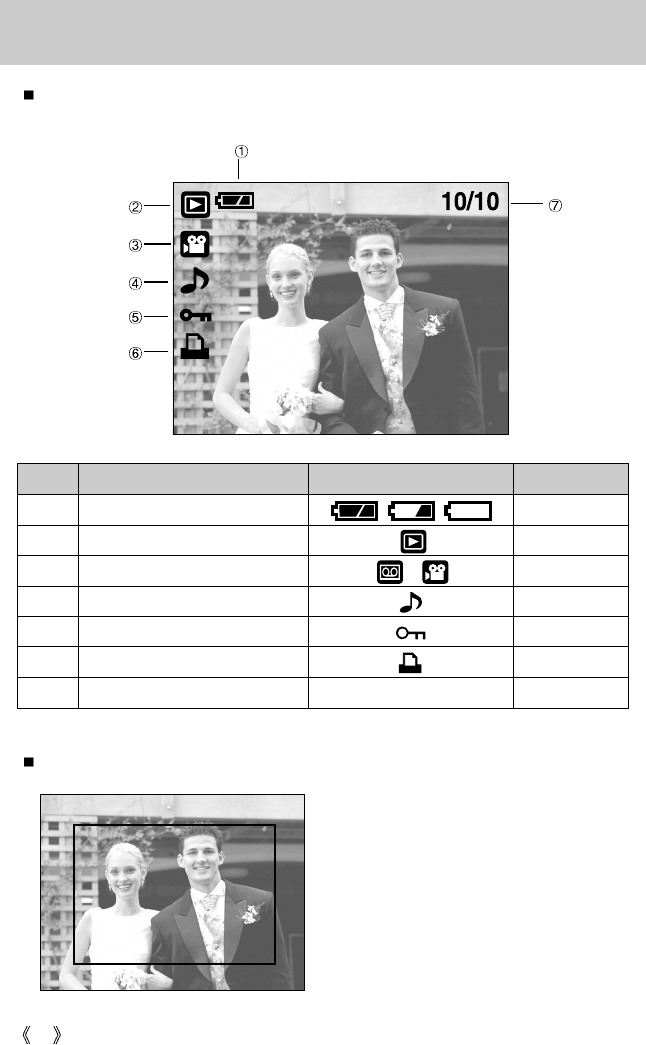
58
LCD monitor indicator
The LCD monitor displays information about the shooting conditions.
No. Description Icon Page
1 Battery p.15
2 Play mode
3 File Type
4 Voice memo p.58
5 Protect indicator p.65
6 DPOF indicator p.68
7 Stored image number 9
Size : 2592X1944 Size
Av : F2.8 Aperture value
Tv : 1/60 Shutter speed
ISO : 100 ISO sensitivity
Flash : Off Whether or not the
flash is used.
Date : 2005/01/01 Recording date
Size : 2592X1944
Av : F2.8
Tv : 1/60
ISO : 100
Flash : Off
Date : 2005/01/01
If you press the LCD button, you can check the following recording information:
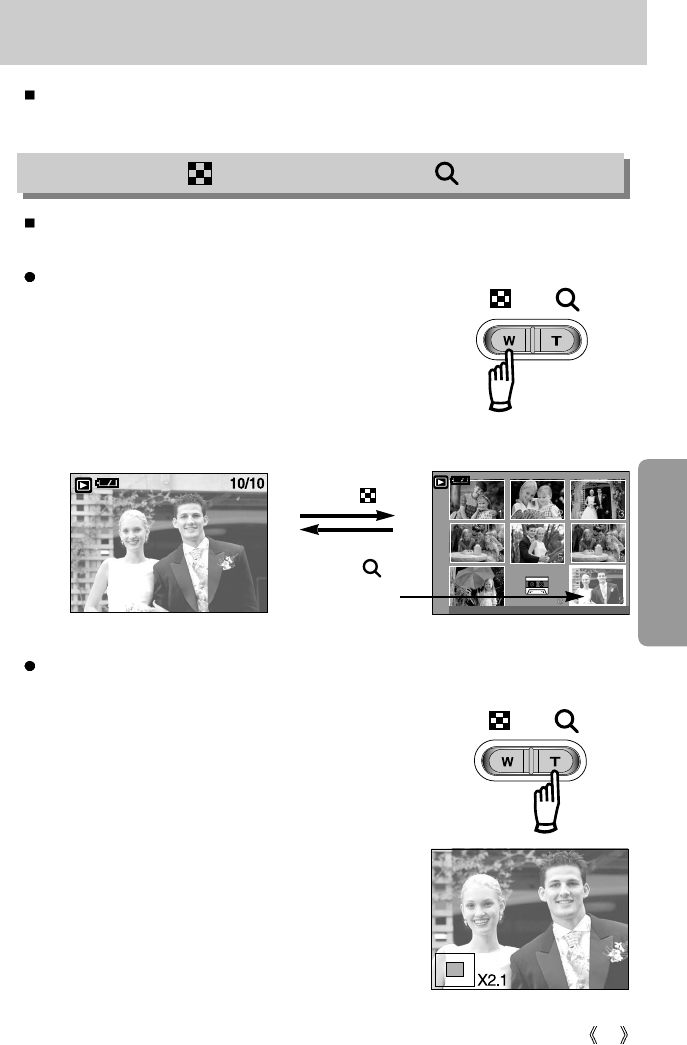
59
Using the camera buttons to adjust the camera
In Play mode, you can use the buttons on the camera to conveniently set up the Play mode
functions.
Image enlargement
1. Select an image that you want to enlarge and press the enlargement button.
2. Different parts of the image can be viewed by pressing
the 5 function button.
3. Pressing the thumbnail button will zoom back to the
original full sized image.
- You can tell whether the image displayed is an
enlarged view by checking the image enlargement
indicator shown at the bottom left of the LCD monitor.
(If the image is not an enlarged view, the indicator will
not be displayed.) You can also check the area of
enlargement.
- Movie clips and WAV files can’t be enlarged.
- If an image is enlarged, a loss of quality may occur.
[ Normal display mode ] [ Thumbnail display mode ]
Pressing the thumbnail
button ( )
Pressing the enlargement
button ( )
Highlighted image
You can view multiple pictures, enlarge a selected picture, and crop and save a selected area
of an image.
Thumbnail display
1. While an image is displayed full screen, press the
thumbnail button.
2. The thumbnail display will highlight the image that had
been showing at the time the thumbnail mode was
selected.
3. Press the 5 function button to move to a desired image.
4. To view an image separately, press the enlargement button.
Thumbnail ( ) / Enlargement ( ) button
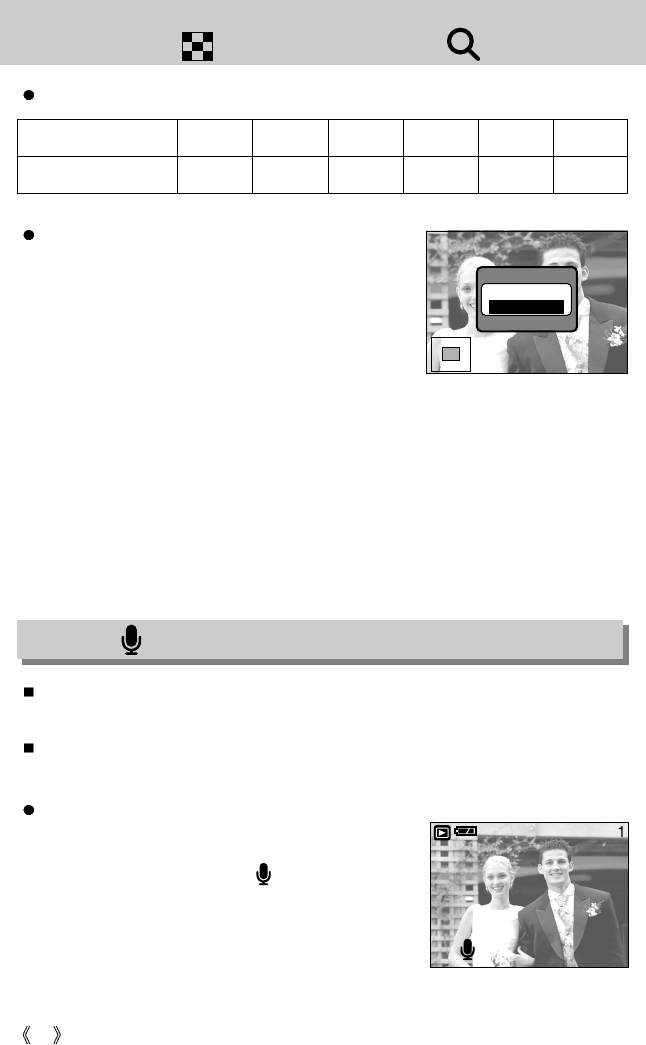
60
Thumbnail( ) / Enlargement( ) button
The maximum enlargement rate in proportion to the image size.
Trimming : You can extract part of the image that you want
and save it separately.
1. Select an image that you want to enlarge and press the
enlargement button.
2. Different parts of the image can be viewed by pressing
the 5 function button.
3. Press the MENU button and a message will be
displayed as shown alongside.
4. Select a desired sub menu by pressing the UP/ DOWN button and press the OK button.
-
[Trimming]
: The trimmed image will save as a new file name, and display on the LCD
monitor.
- [Cancel] : The trimming menu will disappear.
* If there is little memory space to save the trimmed image, the image can’t be trimmed.
* To delete the enlarged image during the trimming function, press the delete button.
Image size 2592 2272 2048 1600 1024 640
Maximum enlargement rate
X10.1 X8.8 X8.0 X6.2 X4.0 X2.5
Voice ( ) memo / Up button
When the menu is displayed on the LCD monitor, pressing the UP button makes the menu
cursor move up.
When the menu is not displayed on the LCD monitor, the UP button operates as the voice
memo button. You can add your voice to a stored still image.
Adding a Voice Memo to a Still Image
1. Press the LEFT/ RIGHT button to select an image that
you wish to add sound to.
2. Press the voice memo button ( ) and the voice memo
indicator will display. The camera is now ready to record
a voice memo.
X2.1
Trimming?
Trim:OK
Cancel
Confirm:OK
Start : Shutter